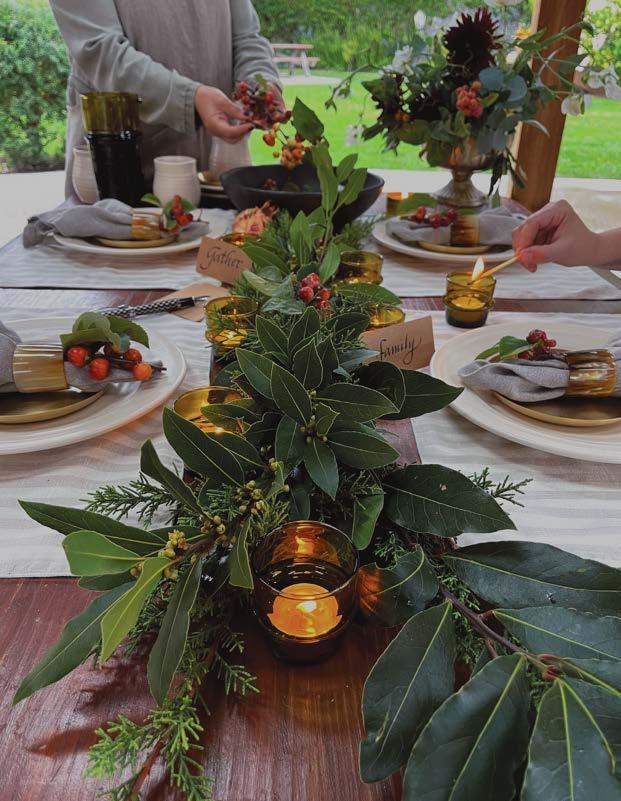
























































Just before the start of each season—when the new issue of Edible Monterey Bay arrives hot off the presses—our small but mighty staff gathers to load cases into our vehicles and we fan out in every direction to supply 375 distributions points.
After working hard to put the issue together, we love to see the excitement it generates when we drop them off and load up our wooden display crates. Each of us has our normal route, but there’s one route we rotate and everyone wants to do it. That’s the Big Sur run.
We only have 12 distribution points in Big Sur and it’s not quick to get there, but oh what a glorious trip! When it’s my turn, my husband and I usually make a day of it, adding a couple of photo stops, some hiking and lunch with a breathtaking view. While each part of the Monterey Bay area has its distinct charms, nothing compares to Big Sur.
We are excited to share a little of our love for Big Sur with two beautiful stories in this edition: the new Matsa Lelima (Earth Ceremony) that members of the Esselen Tribe put together as part of the Big Sur Food & Wine Festival to showcase the foods and traditions of their ancestors; and an introduction to four high-caliber chefs who brought their expertise to Big Sur’s fabled restaurants over the past few months, calling it a once-in-a-lifetime experience.
Winter is one of the very best times for locals to visit Big Sur. The hills have already turned green and there are fewer tourists, especially mid-week. Maybe these stories will inspire you to go.
We also take you to another remote corner of our tri-county area on a tasting tour of the wineries along Cienega Road outside of Hollister, with reporter Mark C. Anderson, who says it’s still a relatively undiscovered gem of a wine trail.
And for those who prefer to stay cozy at home, Amber Turpin and Jessica Tunis have come up with enough cookie recipes to fill a whole platter and keep your kitchen filled with delicious aromas all winter long.
As we enter the holiday season and look back on the past year, it’s clear that the pandemic has underscored how important it is to be part of a resilient community. Edible has always advocated for the value of eating locally, choosing food in season and knowing your farmers, ranchers, fishermen (and women) and food artisans. It’s a way to get clean, healthy food, contribute to the local economy and take care of the planet by shortening the distance between field and plate.
This year more than ever—with supply chain disruptions and shipping delays—we’re happy that Edible readers believe in eating locally and shopping locally. A good place to start is with our advertising partners who make this publication possible. We are so grateful to them and to our dear readers.
Wishing all of you a wonderful holiday season and a spectacular new year!
EDITOR AND PUBLISHER
Deborah Luhrman deborah@ediblemontereybay.com 831.600.8281
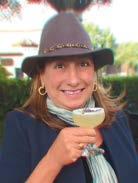

FOUNDERS Sarah Wood and Rob Fisher
CONTRIBUTING EDITOR Mark C. Anderson
COPY EDITOR Doresa Banning
LAYOUT & DESIGN Matthew Freeman and Tina Bossy-Freeman
AD DESIGNERS Bigfish Smallpond Design Savanna Leigh • tracysmithstudio • Zephyr Pfotenhauer
CONTRIBUTORS
Crystal Birns • Jamie Collins
Liz Birnbaum and Gabby Rokeach/The Curated Feast • Magali Brecke • Maria Gaura Kodiak Greenwood • Alexandra Hudson
Michelle Magdalena • Kathryn McKenzie
Laura Ness • Zephyr Pfotenhauer • Geneva Rico Michael Troutman/DMT Imaging Jessica Tunis • Amber Turpin
ADVERTISING SALES
ads@ediblemontereybay.com • 831.600.8281 Shelby Lambert shelby@ediblemontereybay.com Kate Robbins kate@ediblemontereybay.com Aga Simpson aga@ediblemontereybay.com
DISTRIBUTION MANAGER Mick Freeman • 831.419.2975
CONTACT US:
Edible Monterey Bay P.O. Box 487 Santa Cruz, CA 95061 ediblemontereybay.com 831.600.8281 info@ediblemontereybay.com
Edible Monterey Bay is published quarterly. All rights reserved. No part of this publication may be used without written permission of the publisher. Subscriptions are $28 per year at ediblemontereybay.com. Every effort is made to avoid errors, misspellings and omissions. If, however, an error comes to your attention, please accept our apologies and notify us. We also welcome letters to the above address. Thank you.
Deborah Luhrman Publisher









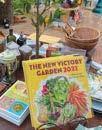






 Feathers, pelts, acorns and abalone shells decorated the long table.
Feathers, pelts, acorns and abalone shells decorated the long table.
The newest event at this year’s Big Sur Food & Wine Festival was also one of our region’s oldest food celebrations—the local Esselen Tribe’s millenia-old Matsa Lelima, or Earth Ceremony.

Matsa Lelima, a groundbreaking collaboration between Big Sur’s Native people and BSF&W, was also one of the festival’s hottest tickets, selling out well in advance of the Nov. 6 event. Just 30 seats were offered to the public, allowing participants to join with tribal members in an ancient Esselen ceremony followed by a feast of foraged foods and creatively re-imagined traditional recipes.
The result was a beautiful and intimate evening full of heartfelt emotion and culinary revelation. And, of course, there was wine.
John Krasznekewicz hosted the gathering on the rolling cliffside meadows of his family’s K Ranch, a stupendously scenic oceanside spot regularly traversed by long-past generations of Esselen. Krasznekewicz has never hosted a public event at his home in the 34 years he’s lived there. But he wholeheartedly welcomed the Matsa Lelima celebration.
“This is an area where the Esselen would summer,” Krasznekewicz said, noting that previous owners had found Esselen artifacts on the property. “There’s an oak grove, strawberries growing back in the canyon and a natural spring. It’s a very spiritual place, where you can see the sun set and the moon rise.
“This event was special and compelling,” he said. “It had such good energy.”
Ironically, the impetus for the celebration sprang from a natural disaster—the massive Rat Creek landslide that plunged a 150-foot segment of Highway 1 into the ocean in February, stranding residents and businesses already reeling from the COVID pandemic.
Compounding the hurt, CalTrans needed to cut through an ancient Esselen site to fix Highway 1, and it had to happen fast. The tribe cooperated, with heavy hearts.
“We decided to hand-excavate everything,” said tribal administrator and secretary Jana Nason. “We had two weeks of 10-hour days, working with archaeologists and tribal members, and it was absolutely heartbreaking.” But the excavation turned up a wealth of culinary artifacts, including kitchen firepits filled with limpet, mussel and urchin shells—evidence of celebrations past.
“As we worked, we talked about recreating ancestral recipes,” Nason said. “We even joked about doing it for Big Sur Food & Wine.”
Inspired by the encounter with her ancestors’ kitchen hearths, Nason began pulling the threads that brought together the Esselen Tribe of Monterey County, festival CFO Elsa Rivera, chefs Nick Balla and Norberto Piattoni, the Krasznekewicz family, winemaker Gary Pisoni and Roederer Champagne.
Nason sent friends and family foraging for dozens of local ingredients—elderberries, herbs, acorns, bay laurel nuts, madrone fruits, mushrooms and hazelnuts—and embarked on the months-




long process of making hand-ground acorn flour and blue corn polenta. Local venison was sourced, and plans were made to harvest seafood and seaweed the day before the feast.
On an improbably warm and sunny November afternoon, all those threads came together seamlessly.
Minutes before the guests arrived, tribal members and volunteers held hands and gathered in a circle to calm their jitters and set the mood.
“I believe all these guests are here because they have an open mind, an open heart, and are yearning to understand,” said Rivera, as sage and wood smoke scented the air. “This will be a nourishing, invigorating event for everybody.”
Arrivals were welcomed with a glass of elderberry and yerba santa tea made by a tribal elder. The cool, wine-colored tea tasted of sweet berry, followed by a hint of chaparral wildness, and a lift to the heart.
Guests then sampled vintage Champagne from Louis Roederer, the 242nd harvest from the historic Roederer Estate winery in France, perfect for savoring the incomparable scenery.
The ocean horizon, viewed from the K Ranch clifftops, appeared curved and iridescent as a vast abalone shell. As the celebration unfolded, Mother Nature provided shirtsleeves weather, a sun-halo light show and a spinetingling moment as scores of pelicans rose from the ocean in an aerial ballet and suddenly, apparently, vanished.
“The ancestors are here with us,” said tribal member Stephen Vicente Arévalo to silent nods all around.

Summoned into a circle, participants unleashed a coyote howl amidst a swirl of cleansing sage smoke.
“What an honor to be on this sacred land of Big Sur,” said tribal elder Tom Little Bear Nason. “Our tribe lived here thousands and thousands of years, continually. We buried our people and birthed our children here.
“The land of Big Sur is the end of the universe,” he continued. “Tribal people know this is the western edge of the universe. A mystical place and healing place. We are honored to
have you here.”

A tall talking-stick topped with a carved coyote was passed around the circle, and Krasznekewicz, visibly emotional, took the opportunity to speak.
“It’s an honor to share my property with the Esselen, because I believe they have shared it with me,” Krasznekewicz said. “I’m so honored to be here.”
And then, it was time to feast.
Appetizers of venison meatballs with madrone berry glaze and mussels with wild-herb chimichurri were followed by a sit-down meal harvested from the surrounding fields, woods and shore.
A long table for 60 was quickly piled with tender acorn flour rolls, spreads of porcini mushrooms and hazelnuts, squash and wild fennel. A green-herb salad came alive with briny shreds of seaweed and pine nut-herb vinaigrette.
The Three Sisters Seafood Stew paired impeccably fresh rock cod with beans, squash and cubes of blue corn polenta in a savory herbaceous broth.
The courses were accompanied by a trio of outstanding pinot noir and a golden chardonnay from Pisoni Vineyards, with winemaker Gary Pisoni generously holding court.
Dessert was a showstopper, with intensely flavored elderberries wrapped in crumbly hazelnut pastry, astonishing bay nut brittle and creamy bay nut chai that felt as invigorating as espresso but without the caffeine.
Not to be outdone, Mother Nature accompanied dessert with a simultaneous sunset-andmoonrise that literally stopped people in their tracks.
As the sun sank behind a flaming orangeand-purple horizon, a gleaming crescent moon reached toward sparkling Venus, across a blue sky veiled in vaporous pink clouds.

As darkness fell, cleanup crews went to work under bright stars and light beams from multiple iPhones, footfalls hushed by the meadow grasses. After an absence of many decades, the Esselen had returned to feast, pray and celebrate on this sacred land.
Maria Gaura is a lifelong writer, journalist and gardener. She lives in downtown Santa Cruz with her family, two elderly cats and an ambivalent garden that can’t decide if it wants to be a vegetable patch, a flower bed or a miniature orchard.





Dick Peixoto had already dedicated himself to farming the conventional way when he became intrigued by organic. His motivation at the time was more about making a smart business move than saving the earth.
Peixoto, founder of Lakeside Organic Gardens in Watsonville, recalls that in the beginning, it was only “crazy hippie farmers” who were growing and selling organic produce. “But I went to the farmers’ markets and got to know a couple of them, and they were making money,” he says with a laugh. And that was enough to set him down a path that would lead to creating the largest family-owned and operated solely organic vegetable grower-shipper in the United States.

On a recent afternoon, Peixoto climbs into his mud-splattered pickup truck and tours the fields next to Lakeside headquarters, waving to workers as he inspects celery that’s being grown for Thanksgiving, as well as several varieties of kale, collards and other crops due for harvest in late autumn.

Lakeside employs around 350 employees, “some of which have been with us since the company started,” says Peixoto, which includes a handful of his family members. “Everyone’s important, they’re all part of the chain that makes it all work.”
Lakeside is now celebrating a quarter-century in business, fostered by innovations and creative thinking that have allowed it to scale up and become a produce powerhouse. “It’s good for the community and it’s good for the Pajaro Valley,” Peixoto says, both of the business he’s carefully nurtured as well as his advocating for organic agriculture, not-
A field crew makes quick work of the rows of green leaf lettuce using short but sharp harvest knives.

ing that “millions of tons” of potentially harmful pesticides and other chemicals have been kept from the valley’s fertile soil over the last 25 years. “I have a lot of pride in that.”
In the early 20th century, Peixoto’s grandfather immigrated to California from the Azores (Portuguese islands in the Atlantic Ocean) and made his living growing potatoes. Peixoto’s father took a different career path—as an agricultural pesticide salesman. It’s a small bit of irony now that Dick Peixoto spent much of his youth riding around with his dad on pesticide sales calls.
On their 15-acre farm, his family grew a little bit of everything for their own use, and while still in high school, Peixoto leased 40 acres and started growing produce. “I bought my first tractor at age 16…I didn’t even know how to start it,” he recalls. His high school ag teacher helped him out, and before long Peixoto was supplying iceberg lettuce to Dole and pickling cucumbers to Del Monte.
After graduating from Watsonville High School in 1975, Peixoto continued to farm conventionally until the early 1990s, when organic began to intrigue him. It takes three years to convert conventional farmland to organic, and eventually 1,000 acres in the Pajaro Valley were transformed under Peixoto’s direction. When some of his farming friends teased him about his “garden,” Peixoto in 1996 turned the
Millions of tons of potentially harmful pesticides and other chemicals have been kept from the valley’s fertile soil over the last 25 years.
jibe into his new company’s name, Lakeside Organic Gardens.
Figuring out how to grow crops with organic fertilizers and beneficial insects wasn’t that hard, Peixoto says. The real challenge was selling organic. Peixoto couldn’t get into the farmers’ markets—well-established local organic farmers already had their spaces staked out—so he began forming alliances with natural foods grocery stores like Staff of Life and New Leaf.
There’s the story that Peixoto simply walked into Staff of Life one day, carrying a box of produce that he had grown, and the produce manager bought it right then and there. To this day, the relationship between Lakeside and Staff of Life is a close one, and the company “is still a big supplier of our produce,” says Staff of Life co-founder Gary Bascou.
Peggy Bascou, Gary’s wife, says Peixoto told her the story of that first encounter, and praised him for the extra support that was needed to open the new Staff of Life store in Watsonville this past March.
Over the years, Lakeside continued to add to the stores it was supplying and enlarging its acreage, ending up with its current 2,500 acres in the Pajaro Valley and another 1,200 in the Imperial Valley, which was added to ensure a reliable year-round supply of produce. Peixoto also found profit was leaking away in shipping charges, so Lakeside started its own packing and shipping department.
Four years ago, the company built a new cooler, a 50,000-square-foot warehouse with the capacity to make 100 tons of ice a day, and provide seven different cooling methods that are used for the various kinds of produce—important because Lakeside grows some 50 different crops.

Peixoto took his organic advocacy in a delicious direction when he purchased the California Grill seven years ago. The Watsonville restaurant showcases Lakeside produce on its menus, and highlights a cornucopia of other local products, including Martinelli’s cider, Gizdich Ranch pies, meats from Freedom Meat Lockers and Corralitos Market, seafood from Stagnaro Bros. and freshly made bread from Golden Sheaf.
He’s also proud of the company’s legacy in protecting the Pajaro Valley from conventional pesticides. One way in which that’s being done is through partnering with other agricultural companies to create buffer zones around schools, with Lakeside farming closer to the



schools to protect children from harmful effects of pesticide drift. He also created an agricultural land trust to ensure that the acreage near Lakeside headquarters will always remain farmland.
During the past 25 years, Peixoto says one of the biggest shifts he’s seen is simply in respect for what organic farmers do. “When I started, organic was seen as hobby farming,” he says. Now, there’s a general respect for organic farming and an acknowledgement that organic produce should be offered whenever possible. “Everyone,” says Peixoto, “should have a choice.”
Lakeside Organic Gardens • lakesideorganic.com California Grill • 40 Penny Lane, Watsonville • 831.722-8052 californiagrillrestaurant.com

Make our spicy and boozy drink for your own festivities
RECIPE AND PHOTOGRAPHY BY JESSICA TUNIS AND AMBER TURPIN
It’s time to celebrate! Edible Monterey Bay enters its 10th year with this edition. So to commemorate this special occasion, we raise a glass to you, dear readers. Ten ingredients—one for each year we have been bringing you stories about our local food community—combine to make one truly delectable beverage. Flavors warm and spicy, crisp and cool, all at once. In keeping with our ongoing kitchen pantry preserve/ cocktail experiments, we use fig jam here to special effect, a subtle note that captures the essence of the season, and lingers on the tongue with a silky mouthfeel.
½ gallon unfiltered apple juice
6 cardamom pods, crushed
2 cinnamon sticks
2 star anise pods
2 tablespoons fig jam
2 cups bourbon
2 12-ounce bottles ginger beer
5 oranges (use 4 to make 2 cups freshly squeezed orange juice and slice 1 into wheels for garnish)

½ cup crystalized ginger, sliced
10 dashes Angostura bitters
Pour the apple juice into a large pot. Add the cinnamon sticks, cardamom and star anise and let simmer for about 20 minutes. Add the fig jam and stir to dissolve. Remove from heat and let cool, then transfer to the refrigerator to chill for several hours or overnight.
Pour the spiced apple juice into a large punch bowl or pitcher, using a strainer to remove the whole spices. Add the bourbon, ginger beer and orange juice and mix well. Top with the crystalized ginger, orange slices and bitters. Add ice to serving glasses if desired. Serves 8.





One of the world’s rarest and most expensive ingredients is set to be harvested in Watsonville
BY MARK C. ANDERSON PHOTOGRAPHY BY CRYSTAL BIRNSSomething spicy is happening in a rural corner of Watsonville. It’s also something beautiful and downright historic.
Out on a 14-acre patch of paradise named Whiskey Hill Farms sit six football field-sized greenhouses. The greenhouses enjoy their own breed of integrative ecological magic: cleverly designed frog habitats allow for chemical-free pest management, carbon dioxide from distilling organic spirits next door supercharges growth, compost piles heat water pipes that in turn keep the greenhouse at temperature and catfish ponds provide fertilizer for even greater yields.
But it’s further back in a corner, past the frog condominiums and methane converter and fish farm, where a different type of green magic is growing. Big heart-shaped leaves radiate out from vertical stalks. Dark, rich soil lingers in the shadows created by the broad leaves. Passionfruit vines crawl through the guiding lattice above, providing protection from the sun and furnishing fruit. The plants below fan out in every direction.
The only wasabi crop being grown in the Salad Bowl of the World—and one of only a few being grown nationwide—is thriving, and fast approaching the first time it will be harvested. Something else is also on the horizon: the day, in the not-too-distant future, when Whiskey Hill is one of the largest producers of wasabi in the U.S.
There are a number of reasons why wasabi presents such a rare vision. For one, wasabi proves notoriously delicate. In its native Japan it grows naturally in coastal mountains in the bottom of shady canyons, nestled in temperate rainforests, next to sandy river bottoms or even directly in shallow creeks and pools. It turns out those conditions are awfully hard to replicate. Wasabi wilts in small amounts of
sunshine or higher temps, and conks out in the cold.
Moreover, unlike other crops that mature on a three-month cycle, wasabi needs a year to fully grow, which ties up land and resources, and widens the window wherein things can go wrong. It also produces very few seeds, and fewer still that are fertile, further complicating propagation. Insects are not into the wasabi burn so farmers need to hand pollinate.
And all that struggle happens only if you can obtain wasabi root to begin with. Not only is it expensive—as much as $200 for a single root—there’s also not much in circulation at all.
“Japan would like to be the only place in the world that grows real wasabi,” says David


Blume. “And they don’t have enough for their own use.”
Blume is the master ecologist behind the systems at Whiskey Hill Farms, a Willy Wonka of waste streams who can seemingly turn anything into revenue.
At the moment the business makes ethanol and methane from food processing discards, sugar cane, fodder beets and cassava roots to power electric grids, transportation and more. It also distills spirits for pharmaceutical and adult beverage deployment.
As this issue was going to press, Blume was heading to Glasgow, Scotland to speak at the Worldwide Climate Change Conference, on how to convert kelp and plastic into fuel.
On a tour around the lush grounds his eyes sparkle as he points out all sorts of new fuel sources Whiskey Hill is working with— raisins, almond hulls, even Halloween candy dentists bought back from kids.
That sparkle appears as he dips into tall foliage to hand harvest heirloom tomatoes and canary-yellow sweet bell peppers.
It resurfaces as he describes a project that just took him to Necker Island to meet with
Compared to the horseradishmustard-pea mashup passed off by so many places as wasabi, he insists this will blow folks away.
Richard Branson about fueling his fleet of boats with his various alcohols, reforesting islands with tropical fruit, capturing rainwater and developing a brand of liquor tentatively called Necker’s Nectar.



It appears as he points out the record amount of turmeric he’s cultivating, which, like wasabi and ginger, is a slow-growing root, or rhizome.

But the sparkle gains a little sizzle when he gets to the wasabi. Compared to the horseradish-mustard-pea mashup passed off by so many places as wasabi, he insists this will blow folks away. Just a few fresh shavings from the root into some soy sauce or on some rice and…boom.
“The thinnest shreds have incredible potency,” he says with a conspiratorial grin. “It takes just a little bit.”

Tom Harvey, executive vice president of Blume Distillation and spokesperson for the farm, estimates it will have wasabi ready to sell to the public as soon as the end of the year, or very early 2022 at the latest. The plan is to educate the public on real wasabi, its availability and how to cook with it, rather than the
Whiskey Hill’s David Blume touts the advantages of locally-grown real wasabi.
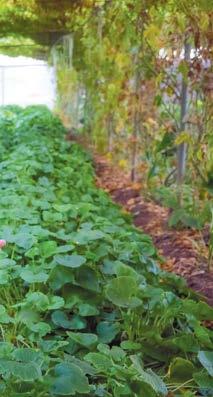



faux wasabi folks are familiar with.
“It’s learning a whole new tool for your cooking, a whole new accessory for food preparation,” Harvey says. “It lends flavor value to a wide variety of dishes, whether that’s stirfries, baked squash blossom or fried fish.”

Cooking classes will line up in early 2022 to coach locals on how to prep wasabi and other Whiskey Hill fruits and vegetables. The organic operation also plans to up participation in farm tours like last month’s Santa Cruz Open Farm Tours, while opening its farm stand to sell everything from passionfruit—a breakout hit at the most recent tour—to turmeric to the farm’s COVID-inspired hand sanitizer.
Discussion of a tasting room is also underway, with a potential debut in 2022. The farm is also considering a CSA, or community supported agriculture, program.


Meanwhile Whiskey Hill is workshopping recipes to ultimately share with the public in partnership with restaurants excited about crafting dishes around fresh wasabi.
“I think local eaters will find, from the leaf down to the root, it’s a nice addition to the cooking experience,” Harvey says. “We’d like to sell volumes of wasabi, sure, but we want to broaden the cuisine experience for the tricounty region to include organic and locally produced wasabi that can enhance and increase enjoyment for everybody.”
One of Blume’s favorite things to do with the wasabi at the moment is take some leaves and a root down to one of his favorite nearby restaurants, Ella’s at the Airport, to surprise and challenge the owner to craft something tantalizing. Of late she’s been steaming the zingy leaves and wrapping them around pulled chicken and vegetables.
It’s a mouthwatering prospect to imagine similar dishes appearing on local menus across the area, and in home cooks’ kitchens too. And a magical prospect to realize this is just the beginning.
Mark C. Anderson is a roving writer, explorer and photographer based in Monterey County. Follow and/or reach him on Twitter and Instagram @MontereyMCA.








Comforting and warm as a hug from grandma, pasta makes the perfect wintertime meal. Fortunately for us there are many great options when it comes to locally crafted pasta. (Clockwise from top left) Pensi Pasta (Marina) spiced pumpkin with sage linguine, spinach shells; Etto Pastificio (Paso Robles) fresh trombe; Goodles (Santa Cruz) cheddy mac; Bigoli Fresh Pasta (Sand City) spinach and ricotta ravioli, sweet potato ravioli; Pasta Mike’s (Santa Cruz) linguine; and Mezzaluna (Pacific Grove) lobster ravioli, squid ink linguine.




The rain finally arrived in October, quenching these dry fields, fire-burnt trees and dusty creek beds like a long-craved gulp of cold beer after a hard day’s work. The Santa Cruz Mountains are not quite the same mountains without this rain, much of it being a literal rainforest of redwoods. The dripping understory, soggy conifer brush and porous web of life that lives and breathes here need the wet. And we, in turn, have come to “need” the forest’s bounty. If wild mushrooms have not appeared on a menu by now, we know we are in a bad situation. And if the drought conditions continue, our local farmers face the same challenge of what to grow using the least amount of water, if any at all. Their efforts and planning are tireless, and we should all support the often unseen and underappreciated work they do to bring us nourishing produce every week at our local markets, year in and year out, come rain or come shine.
Saturday
Aptos Certified Farmers’ Market






8am–Noon · Year-round 6500 Soquel Drive · 831.728.5060 montereybayfarmers.org


Westside Santa Cruz Market
9am–1pm· Year-round 2801 Mission St. · 831.454.0566 santacruzfarmersmarket.org
Sunday
Live Oak/Eastside Farmers’ Market
9am–1pm· Year-round 21511 E. Cliff Drive · 831.454.0566 santacruzfarmersmarket.org






Corralitos Farm & Garden Market
11am–3pm· Year-round 127 Hames Road · 831.724.1332 wayne@catalyst2001.com
Pacific Grove Certified Farmers’ Market
3–6pm· Year-round Central and Grand avenues 831.384.6961 everyonesharvest.org
















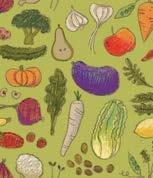
Old Monterey Marketplace & Farmers’ Market
4–7pm Year-round Alvarado Street 831.655.2607 oldmonterey.org
Carmel–by-the-Sea Farmers’ Market


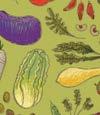


10am–2pm· Year-round 6th and Mission streets 831.402.3870 goodrootsevents.com
Monterey Certified Farmers’ Market
8am–noon · Year-round 1410 Del Monte Center 831.728.5060 montereybayfarmers.org
Old Town Salinas Farmers’ Market
9am–2pm · Year-round 12 W. Gabilan Street, Salinas 650.815.8760 wcfma.org/salinas
Carmel Valley Certified

Farmers’ Market
10am–2pm · Year-round Mid-Valley Shopping Center, 550 Carmel Valley Road 650.290.3549 · wcfma.org
Marina Certified Farmers’ Market
10am–2pm · Year-round 215 Reservation Road · 831.384.6961 everyonesharvest.org
Monterey Certified Farmers’ Market
8am–noon · May through September 1410 Del Monte Center 831.728.5060 montereybayfarmers.org









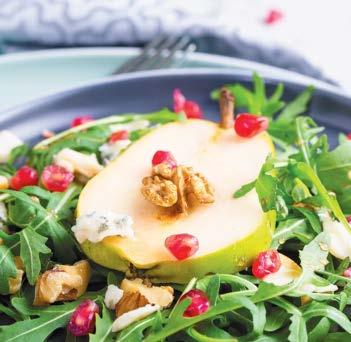











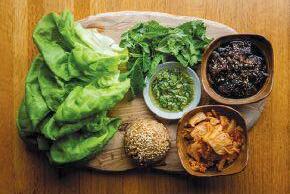
The pandemic brought a new crop of high-caliber chefs to the South Coast’s most fabled restaurants and the slower winter season is a perfect time for locals to discover their food

“I was born at Fort Ord, so this is like coming home,” says Reylon Agustin, who joined the iconic Sierra Mar restaurant at Post Ranch Inn as executive chef last year. As a child, he remembers running up and down sand dunes, watching in amazement as his footprints disappeared. “It was like a giant Etch A Sketch!”

Much of his mother’s Filipino family, including grandfathers and uncles, were in the military. It was his grandmother who fed him daily, inspiring his career. “The fondest part of my childhood was being around a lot of family and tons of food. It’s such a celebrated part of our culture. Food was the way I identified with my culture and tried to preserve it,” he says.
Yearning to cook in the storied kitchens of Europe and learn their secrets, Agustin went to London. “My time at the Savoy Grill was a reckoning,” he says, explaining it was a regimen of exactitude, of strictly following recipes for infallible repeatability. “Auguste Escoffier (the original chef at the Savoy) influenced how the top kitchens in the world are set up. He
invented positions like chef de cuisine and chef de partie.”
A complete contrast to the Savoy was the farm-to-table ethos of chef Traci Des Jardins at Jardinière, where Agustin worked in San Francisco. “She was a huge influence,” he says. “We wrote new menus every day, based on what our farmers harvested. I learned not to be afraid to experiment and bring a dish to life.”
Agustin’s most recent culinary canvas was Michelin-starred Madera at Rosewood Sand Hill in Menlo Park, where he brought innovation to a very traditional menu. Then the pandemic shut Silicon Valley down. “I knew it would be a hot minute before anything returned to whatever the new normal was going to look like,” he says. When the Sierra Mar position came his way, he recognized a once-in-alifetime opportunity to work in another fabled kitchen, where executive chefs Craig von Foerster and John Cox had laid down legend.
He also recognized instantly that the coastal terroir dictates the menu.

“The real difference between Madera and here is that I am one level closer to the farmers, fishermen, mushroom foragers, olive oil and
honey producers. I am picking avocados at a ranch in Palo Colorado, constantly closing that radius. There’s tons of fennel and cactus. I love diving for bull kelp at Moss Landing. It’s super neat to be rediscovering where I grew up!”
In the Post Ranch garden, he pulled out mealy heirlooms and replanted with intensely
flavored dry-farmed tomatoes. Albion strawberries thrive in the ranch’s soils, as do a cross between purple potatoes and German butterballs. “We get 65% of our produce from the garden. We inoculated tree stumps with mushrooms, like lion’s mane, which are popular with guests for their healing properties. We
also make our own seaweed salt for a distinctive umami that captures our terroir.”
Agustin knows he has a lofty tradition to uphold at Sierra Mar. “Guests still talk about dishes von Foerster created. I am lucky enough to have the chance to write my own chapter in the book, but I will do it respectfully. Pride is not synonymous with ego. Be proud of what you do!”
Clearly, he’s not planning on his footprints—or foodprints—disappearing in the sand. —Laura Ness

Garden squash agnolotti with saffron, tarragon and Schoch Farmstead cheese from chef Reylon Austin at Sierra Mar (left) and autumn squash soup with garnish of shaved fuyu persimmon, crispy pancetta, dill and dill oil from chef Tim Eelman at Big Sur Bakery (right).

When Edible Monterey Bay asked longtime Big Sur Bakery owner Mike Gilson what might surprise people about his restaurant’s new chef, he had an interesting response.
“No big surprises here,” he said. “Just big flavors.”
Gilson is partly right. The menu with which executive chef Tim Eelman relaunched BSB’s dinner service last month definitely does big flavor—note the beef short rib with purple sweet potato and nasturtium blossoms, the house cured and smoked whitefish and the dry-aged duck breast he seasons with his own Indian-French vadouvan curry.
But there are some surprises at work with Eelman, who comes over after time with Sierra Mar at Post Ranch Inn and stints at acclaimed San Francisco destination Aster and sustainability pioneer The Perennial.
One surprise might be just how hotly his passion for product runs—he’ll talk at length about how much he loves the fresh-from-theboat black cod he gets from Real Good Fish or the Oaxacan blue heirloom corn he sources from the Tehachapi Heritage Grain Project.
“On a weekly and daily basis, the available product changes,” he says. “That’s just nature.


Visit Our Watsonville Store Mon - Sat 10-5 shop at annieglass.com 310 Harvest Drive, Watsonville, CA | 831.761.2041 x121

We need to adapt our techniques and menu to that, not the other way around. That’s why we keep the menu vague, so we can adapt. What doesn’t change is the flavor, attention to detail and intent that upholds the integrity of the product.”
The sheer depth of new developments at work with Eelman and BSB certainly feel surprising. Rolling out dinner while teaming with pastry chef Raquel Bagatini on a popular lunch service—that features everything from seasonal tuna belly melts to duck confit cassoulet—would be enough to keep most chefs over-occupied.
But Eelman et al are also building out a hot sauce program (soon available for retail sale), a fermentation program (think tomato vinegars and salt-preserved spicy mustard greens), a pizza program (for Sundays), new breakfast service (with an eye on full service mornings come spring) and even a vinyl program (featuring staff and guest record selections alike, with Eelman leaning heavily toward Springsteen).
Chef insists that progress happens only one way. “It’s the team,” he says. “We fuel each other. We can’t sustain having one person excited about things. It’s about making this together. That’s what drives it. When everyone’s rowing and deciding where to go, it makes things much more a joy to be a part of.”
If Gilson has his way, any additional surprises can come from other places than the kitchen. “Big Sur and life in general offer plenty of surprises,” he says.
He’s got a point. While the bakery hasn’t been around nearly as long as the surrounding redwoods, it’s certainly survived wildly eventful times. Its relatively brief existence has already included catastrophic wildfires, mudslides, a months-long shutdown of Highway 1 in both directions and, oh, a global pandemic.
That gets back to other Eelman abilities. When COVID sent shockwaves of closures and uncertainty through the restaurant sphere and beyond, Eelman’s gifts provided a steadying force at Sierra Mar, where Jonathan Rodriguez is chef de cuisine.
“Tim’s strength lies in his versatility,” Rodriguez says. “He was one of the more creative fellas in the bunch, he did a lot to incorporate seasonality and his background as a baker really helped us with fundamental reci-
pes…but more than anything he met every challenge head on with a positive attitude.”
In other words, whether the surprise is a seasonal ingredient or an inevitable South Coast curveball, this chef’s up to the task. —Mark C. Anderson
Deep down in Big Sur, tucked in a series of cylindrical redwood towers, next to a cliff, under a mountain range, without a public water system or cell service, surrounded by poison oak, original art, sunsets, wild beauty and social distance to spare, Nick Balla found a dreamy place to spend the pandemic.
The award-winning chef, author and master bread maker liked it so much he stayed, and he now helms Coast Big Sur’s kitchen.
That wasn’t the plan. But as he started making pilgrimages to consult on Coast’s opening, Big Sur imprinted on his taste buds and his heart. Suddenly plans to return to San Francisco—where he ran a number of restaurants, most famously Bar Tartine, and co-wrote a James Beard award-winning book on the techniques and recipes they developed there—weren’t so appetizing.
“I got hooked,” he says. “Especially during COVID, it was the best place to be. I fell in love.”
He moved south permanently in fall 2020. Under his care, Coast provides Big Sur another destination place to eat.
The tiny menu delivers flavors as expansive as the views. Recent items include a farmer’s cheese tart with king trumpet mushrooms and saag; a Sofia spoon salad with local tomatoes, fava beans, olives, squash and herbs; and a sweet corn and mung bean soup. Those come reinforced by stylish shrubs (note the blackberry and thyme with cider vinegar), seasonal lemonades, local wines, fancy coffee, craft beers and five soft serve ice cream flavors like vanilla bay laurel and chocolate landslide.
The food is driven by plunder that locals unload and the preservation game that populates his book. One autumn day 400 pounds of quince landed in his lap. Other days it’s dragonfruit and avocado, sometimes it’s apple and citrus. While scrambling to preserve the produce, Balla and his nuclear team of
Veronica Ramirez, Angel Vasquez and Natalie Gamboa are also baking like crazy—from rustic Tartine-inspired sourdough to harissa chicken pizza to “everything” cookies—while at the same time fermenting their own koji, miso and soy sauce.

“We’re cooking with what’s around,” he says. “We’re a hub for everyone’s gardens and farms, which sometimes involves getting huge batches. I process things so it doesn’t go to waste, which has always been my shtick.”
While he’s fallen hard for Big Sur, Big Sur has fallen harder for him. Elsa Rivera observes ringside as Big Sur Food & Wine events director and part of the Big Share community food pantry project that shielded hundreds from hunger amid COVID.
“He’s quietly a powerhouse in the community,” she says. “He just says ‘yes’ to every collaboration, asking, ‘What can I do? How can I
help?’ He’s one of those people who will look at the possibilities rather than the impossibilities.”
That meant taking surplus food bank flour to make breads and pizzas, using overflow garbanzos to make hummus and transforming expiring produce into pickles, all of it going to those in need.
“He’s super open and creative but also has a business acumen that brings structure,” Rivera says. “We got really lucky that he lives and breathes zero waste and sustainability.”

According to Balla, the view might be nice, but it’s these types of connections that keep him in his COVID home.
“The biggest draw is being part of the community,” he says. Which gets at the best part of this particular love story: The more Balla and his Coast team contribute to the community, the stronger, better tasting and less wasting the community becomes. —Mark C. Anderson
Chef John Garcia is used to living in far-flung locales over his two decades long cooking career. Eight years working for Ritz-Carlton landed him in both California and Puerto Rico, a stint at the Bellagio Hotel took him to Las Vegas then more recently he was at Rosewood Mansion on Turtle Creek in Dallas. But his current position as executive chef at the iconic Alila Ventana Big Sur, overseeing both The Sur House and the newly reopened Big Sur Smokehouse, is placing him at a once-in-a-lifetime post on this remarkable coastline we call home. “Big Sur is an absolutely gorgeous location and the property is truly breathtaking,” he says. “The team is eager to learn, hungry to be the best and the natural resources make it incomparable.”
That team that chef Garcia is quick to honor and this area’s abundance are, in fact, the two main tenets that drive his cooking. “My inspiration comes from everywhere, an ingredient at its peak, a whiff of fresh lavender on the property, my team. My team inspires me, I truly enjoy asking them to cook what they would have at home, especially my interns because they come from different backgrounds, plus it gives them a chance to cook from their heart. That’s when you see what they love, and the conversations that come from that is what makes this job fun,” he says.
Garcia has been having fun in restaurants most of his life, while also appreciating rural living. He grew up on a former walnut orchard in Chino, when that part of San Bernardino County was still mostly farmland. His father, a mechanical engineer for the U.S. Postal Service, had a dream to raise his kids on a farm, so he started one with about 30 black angus cattle, ducks, chickens, pigs, sheep and a huge vegetable garden.
“Around this time my father also decided he wanted to open a restaurant,” recalls Garcia, “so we opened Joey’s Bar-B-Q in Anaheim serving original Texan recipes. That’s where I actually got the itch to be in the kitchen. I spent every free moment helping make sausage, chili, beef ribs and being the
dishwasher.” Side note: Big Sur Smokehouse recently picked up honors at the Santa Cruz Beach Boardwalk Chili Cook-Off, so it seems Garcia knows a thing or two about that dish.
The main turning point for Garcia’s culinary career came right after high school. His grandfather, who was executive chef at The US Grant Hotel in San Diego for 28 years, always had an influence on him, teaching him how to break down whole fish, tenderloins, rib roasts, lamb and whole chickens. After a brief interlude when Garcia studied to become a corporate lawyer, he took a day job at a hotel restaurant and realized that’s where he was most happy. “Of course my grandfather tried to talk me out of it, telling me my hands will hurt, my feet will hurt, I'll never see my family on holidays...the more he told me no, the more I told myself I can do this!”
Fast forward to today and Garcia is continuing in those familial kitchen footsteps,
Chef John Garcia grew up on a farm and has been working in restaurants since he was a kid.

using the seasonal bounty that surrounds Big Sur. As the restaurants transition from fall into winter, menu items like butternut squash soup with duck confit and lavenderinfused Fogline Farm chicken with truffle jus are a few favorites. He is also working on an anise-rubbed venison dish with a traditional mole, pepper chutney and sweet potato.
What he loves to eat most when he isn’t working is something simple, but filled with nostalgia. “I enjoy braised items because you build on the flavor, you can taste the depth of ingredients and it just feels like home and brings back memories from when my mother cooked. I think food does that to everyone, or at least should. It should transport you to a memory or time in your life.” —Amber
Turpin




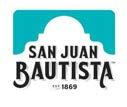


Make these spicy, sophisticated cookies for the adults in your life RECIPES AND PHOTOGRAPHY BY JESSICA TUNIS AND AMBER TURPIN

Season of sweetness and warming spices. Season of gathered friends and abundant serving platters. Season of giving and receiving, season of evergreen needles and lit candles. Cookie season, that’s what it is. These recipes complement each other so beautifully, arranged on a platter, it’s hard to pick just one as a favorite. Luckily, you don’t have to. Want to be the star of the annual cookie exchange? We have you covered here.
These are so good, you don’t miss the gluten one bit. Rich sesame flavor, chocolate chunks and dense texture satisfy and delight.
1 cup tahini
1 cup brown sugar or coconut sugar 2 eggs 2 teaspoons vanilla extract ½ teaspoon salt ¾ cup chopped chocolate
Preheat the oven to 350° F. Line an 8x8-inch baking pan with parchment paper, leaving some hanging over the edges for easy removal.
In a large mixing bowl, combine the tahini and the sugar and mix well until smooth. Add the eggs, vanilla and salt and stir well until thoroughly combined. Mix in the chocolate chunks.
Spread the batter into the prepared baking pan and bake for about 25 minutes, being careful not to overbake. Remove from the oven and let cool slightly. Carefully lift the parchment out of the pan and let sit until cool. Cut the blondies into small squares. Makes about 2 dozen cookies
What a delicious way to celebrate our local, native conifers! Make sure you can identify the tree you want to use, as some trees with needles, like yew, are not safe to ingest. Our local douglas fir, coast redwood and various species of pines are all delicious in their own way, though; nibble some foliage to get a sense of the flavor, if you are unsure. Mincing the needles finely lets the flavors release into the buttery dough, while the texture remains smooth.
1½ cups butter, softened 1 cup sugar, divided ½ cup conifer needles (douglas fir, redwood, pine, etc.), finely minced 2 teaspoons lemon zest ½ teaspoon salt ½ teaspoon vanilla 2 teaspoons orange zest 1 teaspoon lemon juice 3 cups flour
Gather several foot-long branch tips from any of our local native conifers. Douglas fir, redwood and various pine species are all excellent, flavorful choices. (Those without access to these trees can substitute rosemary, if desired.) Use sharp trimming scissors to cut the needles finely, directly off of the twigs. Alternatively, pulse needles (removed from branches) in a food processor, or mince finely with a sharp knife. Measure ½ cup minced needles.
Combine about ½ cup of the sugar with the minced conifer needles and the lemon zest in a mortar and pestle to release the flavorful oils. If you don’t have a mortar and pestle, just combine in a small bowl and let sit until ready for use. The longer it sits,
the stronger the flavor. You can also mix the sugar and conifer needles together and store them in a jar, for several weeks ahead of time, to use as flavoring for these and other baked goods.
In a large mixing bowl, combine the needle mixture with the remaining sugar, butter, salt and vanilla and cream well until fluffy.
Add the orange zest, lemon juice and flour, ½ cup at a time. The dough will be crumbly at first but the zest and juice help keep it together. Gather dough with your hands and roll into an oblong log. Chill for at least 1 hour in the refrigerator.
When ready to bake, preheat the oven to 350° F. Remove dough from the refrigerator and slice with a sharp knife into ¼-inch-thick rounds. Place on a baking sheet lined with parchment paper and bake for about 10 minutes. Makes about 3 dozen cookies.
Contributors Amber Turpin and Jessica Tunis live in the Santa Cruz Mountains and have been friends for a long time. They share a love of food and writing, adventure and good company.

They’re classic for a reason, but this recipe takes them to the next level. Spicy not only from the ginger, but also from the complementary heats of cayenne and ground pepper. Crispy as a gingersnap should be; the melted butter helps with that, and the small amount of milk adds just enough moisture to help bind together the relatively dry dough. While pressing the just-baked cookies down with a glass is unusual, it helps make them denser and crispier—a worthwhile extra step.
½ cup salted butter, melted then allowed to cool ½ cup granulated sugar, plus more for topping
¼ cup dark brown sugar
1 large egg yolk
½ teaspoon vanilla extract
1 tablespoon whole milk
2¼ teaspoons ground ginger
½ teaspoon ground cinnamon
¼ teaspoon ground cloves
1/8 teaspoon ground cayenne pepper
Scant 1/8 teaspoon ground black pepper
2 tablespoons unsulphured molasses
1 tablespoon crystallized ginger, finely minced (optional)
1½ cups all-purpose flour
½ teaspoon baking soda
¼ teaspoon salt
Preheat the oven to 325° F.
In a large bowl, combine melted, cooled butter, white and brown sugars, vanilla extract, egg yolk, milk and spices.
In another bowl, combine the flour, baking soda, salt and, if using, the minced crystallized ginger. Add incrementally to the sugar mixture until dough forms.
Spread a small measure of granulated sugar on a plate. Using your hands, form the dough into balls of about 2 teaspoons in size, and roll the balls through the sugar to coat.
Space the cookies 2 inches apart on a greased cookie sheet, and bake in the preheated oven for 15 to 20 minutes.
Remove the cookies from the oven. They will have puffed up somewhat while baking. Immediately after removing from the oven, use a clean, flat-bottomed glass to flatten the cookies firmly down. This will help them firm up and stay crisp, as well as give the cookies a classic, flat gingersnap look. Makes about 3 dozen cookies.
Dense, dark nuggets with unexpected heat from cayenne and black pepper, these chonky darlings will warm you from the inside out.
1½ cups flour
¾ cup unsweetened cocoa powder

½ teaspoon salt
¾ teaspoon cinnamon
¼ teaspoon black pepper, freshly ground
¼ teaspoon cayenne pepper
¾ cup butter, softened 1 cup sugar
1 egg
1 teaspoon vanilla
1/3 cup cocoa nibs

In a small bowl, whisk together the flour, cocoa, salt and spices and set aside. In a separate mixing bowl, cream the butter and the sugar until fluffy, then add the egg and vanilla and mix until thoroughly combined. Add the dry ingredients and mix until almost all incorporated. Add the cocoa nibs and continue to mix until just combined. Refrigerate dough for at least 30 minutes.
Preheat the oven to 350° F. Line a baking sheet with parchment paper and set aside. Pinch off pieces of the chilled dough and roll into 1-inch balls. Place balls about 2 inches apart on the prepared baking sheet. Press a fork firmly into the top of each cookie to create indentations and slightly flatten each ball. Bake for 8 to 9 minutes, watching carefully to prevent burning. Remove to rack and cool. Makes about 3 dozen cookies.





It began every December with a sausage grinder. Fitted with the smallest plate, the aluminum grinder was brought out and dusted off, clamped to the slab table, and a small bowl was fitted beneath the grinder plate. Instead of meat, however, we ground whole, shelled almonds. Pounds and pounds of them, reduced to a meal of such a particular, fine texture that there was no option but to grind it ourselves. The children, hungry to participate, were often given the task of grinding the nuts, though doubtless we hindered as much as we helped. Still, it was Tradition, and we longed to be a part of it.
Growing up, we had few formal traditions; unmoored from the structures of church and town life, we existed mainly in a small, rich world of forest and family. One of the few traditions we kept was making several kinds of German Christmas cookies. There were hazelnut meringue cookies, lemon bars, sprinkle sugar cookies and pecan crescents, but the most beloved and anticipated cookies were the spitzbuben; a pair of buttery almond cookies, with a layer of jam sandwiched in the middle and a dusting of powdered sugar on the top.
own, I realized the ways in which our own recipe diverged from staunch tradition, and how transmutable a secret, beloved family tradition might, in fact, be.
My mother always cautioned that her recipe be kept secret; it was a particular fear of her own mother, that the recipe might be discovered and thereby cheapened by commercial production, à la Nabisco. But her spitzbuben were so beloved by friends and family that the demands of making a tin of cookies for every family that desired them became expensive, time consuming, and exhausting. So the recipe was shared with those who could be trusted to keep it secret, as a kind of self-preservation. I imagine the ghosts of grandmothers past, hovering over the mixing bowl, shushing and tsking the looselipped generations.
They might have comforted themselves, however, with knowing how particular the dough was, and how vulnerable to the vagaries of oven heat, brand of butter, temperature of the dough and myriad other variables that made these cookies our own. Every baker has discovered that their cookies have turned out a just a little bit different. And of course, every baker considers theirs to be the best.
Roughly translated, the name spitzbuben means naughty or mischievous boy; these cookies are so good that a mischievous boy (or girl) can hardly resist stealing them from the tins. In Switzerland, the reference to a naughty boy is sometimes enhanced by using a different cookie cutter for the top, with a trio of round holes suggesting a face. But we entertained no such practice in our home. Spitzbuben were cut from the buttery dough with nothing other than a crystal shot glass, the same cutter for top and bottom, and they had to be filled with a tart, seeded raspberry jam. As I grew older and began to make these cookies on my

Red currant jelly was the original approved filling for these cookies in our family, the recipe brought to New York in 1931 by my grandmother Anneliese, who had inherited it from a long line of German mothers and grandmothers before her. She carried the recipe in her mother’s handwritten recipe book, written in a flowing, flowery German script. However, red currant jelly was hard to find in Yonkers, so red raspberry was substituted, and thereby became the standard.
When my mother left home for California in the early ’60s, she took this recipe with her, making the cookies first in an apartment in
In which a beloved heirloom recipe may or may not be revealed
San Francisco and later in the small one-room cabin in the Santa Cruz Mountains, which would expand to become our family home in years to come. When she went in search of raspberry jelly, however, all the local grocery store stocked was a seeded raspberry jam. And so began her own tradition. Anneliese did not approve, claiming the seeds were a distraction, and the cookies too firm, somehow.
I have continued to use seeded raspberry jam in my own version of these cookies and follow my mother’s recipe faithfully. The seeds are a crucial part of the recipe; I missed their texture one year when we used seedless jelly. The actual ingredients are few: ground almonds, sugar, butter, jam and powdered sugar to top it off. But our cookies are substantially different, to the discerning cookie-eater, in taste and texture. A friend’s generous gift last year of several pounds of Kerrygold butter (not my usual brand) dramatically changed the flavor of the dough. It was excellent! But somehow…off. Not the usual profile.
This is a tender dough, almost shortbread-like in its richness. As such, the butter must be kept cold, and the dough chilled between rolling. My own practice has been to use frozen butter, and grate it into the dough with a cheese grater, which makes mixing easier. But my mother scoffs at this innovation, preferring to cream the fridge-hard butter and sugar with a wooden spoon. However it is mixed, the dough is temperamental; it does not like to be handled more than necessary, or it becomes tough. On warm days, it must be refrigerated between repeated rolling out. The oven also plays a subtle role in how the cookies turned out; even when my mother lived for a while in another town, she’d come back up to her old mountaintop Wedgewood oven to make these cookies. “They’re just not the same in another oven,” she remarked, and she was right.
The Internet has stolen many secrets from us; places and stories and recipes that were once closely guarded knowledge are now free to anyone who can use a search bar. There are several recipes available online these days for spitzbuben. None of them, however, is my family’s exact iteration. And so, in deference to the ghosts of all my maternal grandmothers, I offer up not our own beloved recipe, but a close facsimile. I compiled it from several online versions and tested it for you. It makes a damn fine cookie, even if it isn’t exactly like mine, or my mother’s, or my grandmother’s. When you make it, it will become exactly your own, part of a long line of changing, eternal tradition and evolution.
Jessica Tunis lives in the Santa Cruz Mountains and spends her time tending gardens, telling stories and cultivating adventure and good food in wild places.
1¼ cups cold butter, cut into small pieces
1 cup sugar
1 teaspoon almond extract
1 teaspoon vanilla extract
2 cups flour, sifted, plus more for rolling out
1½ cups ground almonds
10 ounces tart jam, such as raspberry or red currant About 1½ cups powdered sugar
Preheat oven to 375° F. Grease 4 cookie sheets lightly with butter.
In a large mixing bowl, cream butter and sugar together until smooth. Add the almond extract and vanilla extract and stir.
Sift the flour onto the butter and sugar mixture and stir to combine. Add the ground almonds and mix just until well combined.
Divide the dough in half and shape it into disks. Allow disks to chill in the refrigerator for 10 minutes.
Dust a flat surface lightly with flour. Roll the chilled dough out evenly onto the floured surface, using a floured rolling pin. Roll out to ¼-inch thick, or slightly thinner.
Using a 1-inch in diameter round cutter, cut the dough into small round cookies. It’s helpful to dip the cutter in flour every few cuts, since this dough can be sticky.
Using a thin metal spatula, lift the cookies onto the greased cookie sheets, spacing them ½ inch apart. Bake in the oven at 375° F for 10 minutes or until golden.
Allow the cookies to cool on the baking sheets for 3 minutes, then transfer them individually with a spatula to a cool work surface.
Dollop a teaspoon of jam onto half of the still-warm cookies. Choose the prettiest, roundest cookies to be the tops, and place them on top of the jam to make a sandwich.
While the cookies are still somewhat warm, sift powdered sugar over the tops of the finished jam sandwiches. (The sugar won’t stick as well if they are allowed to cool, so work in batches while the next sheets of cookies cool, rather than all at once.)
Once thoroughly cool, store the cookies in airtight tins, between layers of wax paper. Makes about 30 cookies.
She carried the recipe in her mother’s handwritten recipe book, written in a flowing, flowery German script.
Discover the up and coming wine trail just a short drive from the coast STORY AND PHOTOGRAPHY BY MARK C. ANDERSON
The property that now comprises Eden Rift (pictured here) and its neighbor DeRose is the same place a French immigrant planted here way back in 1851.

“It’s cooler than you think up here,” she says.
Amy Vogt, Eden Rift Vineyards’ chief of marketing, is talking about the climate conditions that make San Benito County great for growing wine grapes. But she could be talking about a number of other factors.
There’s the family feel of the various wineries, both literal and figurative.
There’s the sheer amount of vinicultural history, which predates Napa Valley’s.
There are the special soils and other geological elements— thanks in large part to the San Andreas Fault that pushes limestone, granite and other character-creating substances to the surface—that make terroir nerds blush.
There are rock-star winemakers woven into its past and present.
There’s an ongoing shift to organic grapes widening, just as demand is spiking.
But, yes, the weather is cool too. Chilly air from the Pa-
cific rolls down the Cienega Valley and meets elevations that enjoy naturally lower temperatures themselves. That eases heat on grapes that bask in warm days, allowing them to ripen longer, balance acidity and develop deeper complex flavor. Humidity is low, which limits mildew and makes organic efforts easier.
Over here people expect harsh Hollister-like heat, but instead it’s steadily mild, resulting in powerhouse pinots, chardonnays and other less common varietals such as cabernet pfeffer.
Growers like to point out their appellation is only 25 miles from Monterey Bay, and that the average temperature is lower than the more celebrated Santa Lucia Highlands on the edge of the Salinas Valley.

“The Cienega Valley location is really unique,” Vogt says.
But despite its high coolness quotient—and value price points to boot—the valley’s relatively low profile abides, making it one of the best under-the-radar wine discoveries in the West.
Eden Rift reveals itself to be simultaneously old and new, making it a tidy representative of the area’s rich back story and compelling potential.
The history should come first, and it certainly hits visitors early when they arrive at the 500-acre property and lay eyes on the Dickinson House, built in 1906 by Frank Lloyd Wright acolyte Walter Burley Griffin.
The grape heritage stretches further back from there. The property that now comprises Eden Rift and its neighbor DeRose is the same place a French immigrant planted here way back in 1851, when Charles Dickens was in his prime and no vines had yet been sown in Napa or Sonoma.

Between then and now came a lot more history, but also a lot of flux and low-quality bulk wine. The welcome news for wine lovers is that fresh ownership in 2016 brought a healthy obsession for restoring small-batch pinots and chardonnays that can flourish in the loamy, limestone soils on south-facing terraces.
New owner Christian Pillsbury is a lifelong wine enthusiast turned brand ambassador who was mentored by pioneering wine importer Martine Saunier and made good coin too
while promoting Coravin wine technology.
He takes sizable pride in his Burgundianstyle site that can produce exponentially more grapes, but instead limits production so winemaker Cory Waller can be selective.

“There’s a traditional feeling in American business that you should maximize everything all the time,” Pillsbury says. “If you look at intentionality, authenticity, quality and stewardship, these are not attributes that respond to that feeling. If we were into production or efficiency, we should be in another business.”
On my visit, a sommelier colleague Mike Duffy and I tried a whirlwind of memorable wines as part of an epic ATV tour that rambled into every corner of the vineyard. The chardonnays stood out for their surprising synergy of richness and acidity, the pinots for their focused fruit, the old-vine zinfandel for its lively pepper-blueberry flavors.
But more than anything the land did the talking.
“I like the terroir-forward approach,” Duffy says. “You can tell it’s not manmade.”
Winemaker Waller is happy to hear that.
“We’re not trying to bring something out of the vineyards that aren’t there,” he says. “If
we need more concentration or structure, we can do that through farming, more naturally. I don’t like to add anything, or even filter if I don’t have to.”
Waller feels the area’s familial connections as much as anyone. He grew up in Hollister, attended school with his neighboring winemaker Alphonse DeRose and—after wine work took him from New Zealand to

Oregon—served as assistant winemaker a few miles down the road at Calera, where the winemaker is…his brother Mike.
Their fans expect brotherly competition but encounter little.
“Don’t get me wrong, we do talk s***, but I will say, ‘That wine was rad, good job,’” Cory says. “We’re kind of each other’s biggest fans.”
Eden Rift owner Christian Pillsbury and winemaker Cory Waller, previous page. Calera winemaker Mike Waller and Calera’s underground caves, on this page.
If Bill Murray’s character from Lost in Translation were a wine, it would be Calera.
In one of the quirkier plot twists to be found on serpentine Cienega Road: While still a low-key legend in its backyard, Calera is a hit in Japan. (To be fair, Calera’s also a sommelier cult favorite.)
The main reason: Calera Winery founder and original winemaker Josh Jensen. After a popular Japanese comic strip compared his pinot to that of his early mentors’ at Domaine de la Romanée-Conti, he would do sold-out speaking tours across Japan, describing the merits of his Californian take on Burgundy’s best.
“I never wanted to just sell our wines in Hollister and San Benito County or Monterey County. Right from day one I started selling in 10 other states,” Jensen told EMB in 2015. “I thought it shouldn’t just be people in California who get to drink Calera; it should be people all across the country and in wine markets in different parts of the world.”

Away from the spotlight, Jensen lived on a corner of the vineyard with several cats, tending vines on the Mt. Harlan spot that enjoys its very own AVA designation.
That life changed in 2017, when he sold the vineyard and brand to storied Napa-based wine house Duckhorn—but not without leaving it in very capable winemaking hands.
Winemaker Mike Waller believes his main charge is expressing place, carrying on what he learned working with Jensen for a decade and a half, after studying wine at UC Davis and coming over from Chalone Vineyard.

“My main duty is to do it true to the way we’ve always done it,” says Mike, who is into his 15th vintage with the property. “It’s about expression of site. I’m not changing anything. I feel I have an obligation.”
On a sunny day, our group sat at picnic tables on the edge of a yawning canyon testing out a brut rosé and four pinot noirs. The rosé was lean and light, but it was the pinots that soared. A 2018 made with Muns Vineyard fruit, and three single vineyard Mt. Harlan pinots all enjoyed their own ripe
fruit-driven identities, but they also somehow shared a smoky, mineral-rich and lightly spicy character that lingered on the palate and the imagination.
So the quality hasn’t changed any more than the view.

Alphonse DeRose is barely into his 40s, but he’s served as winemaker at DeRose Vineyards for 22 years. So it goes when you rep the 10th generation in the family making wine.
DeRose was all-in on #grapelife long before he left to study enology at Fresno State. He was sold in elementary school.
“It was cool to learn how to drive a 40,000-pound Caterpillar tractor when I was 10,” he says. “I’ve always loved being outside, so for me this was the perfect place.”
It’s also a great place for a wide range of grapes.
The DeRose extended family—including his self-taught winemaking (and gloriously mustachioed) pops, various uncles, grandma and a family friend—knew as much when they acquired the former Almaden Vineyards property in the 1980s. It came with a history that borders on the unbelievable.
A quick sample: It’s the first commercial winery in California. Thanks to some Prohibition “banditry,” to use Alphonse’s vernacular, it remains the oldest continually operating winery in the country.
Guinness World Records once flagged it as “the world’s largest covered wine cellar.”
On our visit Alphonse and his brother Tony manned the unassuming tasting room/ working winery space and its soaring ceilings, massive barrels, cosmopolitan retail bottle rack and kitschy T-shirt selection (“I’ve been vacZIN-ated at DeRose”).
The super-old-vine zinfandels are a rarity nationwide and a vineyard hallmark, covering around 40% of its acreage. But most memorable for many visitors are varietals they’ve never encountered: peppery cabernet pfeffer, a product of early Cienega Valley planting and tweaking, and my favorite, a wine called négrette.
The midnight inky red, also known as Pinot St. George, throws a floral show for the nose, lays silky tannins and big plum on the tongue, and offers a thoroughly fun way to fall in love with the unknown.

“I enjoy making different stuff, to introduce people to something they haven’t had before,” DeRose says, “and it’s nice to preserve grapes that might’ve been lost, like saving a little piece of history and keeping it alive.”
The industrial but airy indoor setting provides a dynamic venue to taste through their expansive catalog. Even better for a sunny afternoon are DeRose’s sizable new garden patios, which await across the street, next to vines and encircled by barrel stave fences and bocce ball courts.
Expanded outdoor options present a wel-
come upside to the COVID crisis. But Alphonse DeRose and both Waller brothers each allude to another positive change that took hold amid lockdown.
It’s more subtle than seating, but ultimately more central to the AVA’s soul.
“There’s a lot of good energy out here,” Eden Rift’s Cory Waller says. “There wasn’t that camaraderie 15 years ago. Now everyone gets along and is supportive of each other.”
A crazy bit of Hollister history happened in France 121 years ago. At the world-class 1900 Paris Exhibition, where judges tasted 10,000 wines over 12 weeks, a Hollister local named William Palmtag earned a silver medal.
He grew grapes at the property that today includes Eden Rift and DeRose; Eden Rift even has a pinot named after him. Palmtag originally bought the land from Theophile Vaché, a French immigrant who planted the state’s first commercial grapes while squatting there on Mexican Land Grant ground—but that was just the beginning of the action Palmtag brought to the area.
He ran a cigar and spirits business, held leadership positions at Bank of Hollister, brokered steamship trips and lumber sales, and served terms as Hollister’s trustee (i.e., mayor) and treasurer of the county ag society.
My favorite stanza in his story was how he used the property as a getaway destination
It’s the first commercial winery in California. Thanks to some Prohibition “banditry.”
that hosted dancing (in the fermenting room) and added a bath house and pool to go with the vineyard, orchards and cattle/sheep ranch.
Legend holds local farmers and the “dry” contingent in the community were not into that. They wanted to keep things quiet and sober.
So they dug up the road and cut trees to block it.
Local reporter and photographer Robert Eliason of nonprofit news bureau BenitoLink plugged EMB into that history as part of his work documenting area heritage, with a focus on wine.
While no one is blocking roads these days, limited lodging and relative remoteness will continue to keep Cienega Wine Country under the radar.
DeRose puts it well. “You’re not accidentally stumbling upon us or finding us next to the highway like Paso Robles,” he says, “and that’s kept us underdeveloped.”
Something resembling destination status could change that. Eliason envisions a tidy Cienega Wine Country tour that visits nearby Eden Rift, DeRose and Calera.
Meanwhile talk of Taste of San Benito showcases, hosted in the Bay Area, grows louder. A more organized vintners and grow-

ers alliance couldn’t hurt either.
“There’s an underlying desire for these folks to do something to reflect their closeness as a winemaking community,” Eliason says.
One reason insiders believe it’s ready for a closer look: Pros in the know are already all over it. (For more on the vineyards of San Benito County see the online version of this story.)
“We’re getting more attention, though from the consumer perspective not so much,” Mike Waller says. “It’s from the wine geeks buying grapes and making wines.
“Because we’ve been out of the limelight for all these years, they realize it’s untapped territory.”

Which, for discerning Monterey Bay wine lovers, is a beautiful place to be.

Mark C. Anderson is a roving writer, explorer and photographer based in Monterey County. Follow and/or reach him on Twitter and Instagram @MontereyMCA.
Calera Wine Co. • 11300 Cienega Road, Hollister • (831) 637-9170 • calerawine.com
DeRose Vineyards • 9970 Cienega Road, Hollister • (831) 636-9143 • derosewine.com
Eden Rift Vineyards • 10034 Cienega Road, Hollister • (831) 636-1991 • edenrift.com
Winter rains bring scores of cone-tipped redwood branches, usnea lichen bundles and madrone berries to the forager’s collection basket. The bright flavors of these forest gems are bound to enchant the epicurious and leave holiday guests intrigued about your mysterious ingredients. With this recipe we take a journey through the magestic redwood ecosystem for our inspiration and ingredients to prepare a panna cotta that is unique to our bioregion.
The citrus-like flavor and immune-boosting properties of redwood needles infuse easily into heavy cream. To make redwood-infused panna cotta, we employ an herbal medicine technique, mixing shredded needles with a bit of high proof alcohol before infusing them into the cream; for those short on time, this step can be omitted.
Huckleberries can be harvested in late summer, then frozen and prepared as compote for bursts of brilliance in the winter. Huckleberries resemble their relative, the blueberry, (which can be substitued when wild huckleberries are not available) and fruit prolifically in sundrenched spots.


75 grams (about 3 cups) young redwood needles; pine needles or fir tips can be substituted
¾ teaspoon high proof alcohol
3 cups heavy whipping cream ½ cup whole milk ½ cup honey


¼ teaspoon salt

3 tablespoons water 3 teaspoons gelatin powder
1 tablespoon coconut oil
For 1 cup huckleberry compote 1 cup huckleberries, frozen or fresh, wellcleaned of stems and leaves
1/3 cup honey
¼ teaspoon vanilla extract Pinch of salt
Snip redwood tips straight into a blender. Add alcohol and blend until finely chopped. Cover and let sit for 1 hour. Mixing an herb with a little splash of alcohol before oil extraction (which happens in the fat of the cream) helps intensify the flavor.
Heat cream and milk to a simmer and pour over the redwood tips. In a variable speed blender, blend first on low and slowly increase to high and let whir for about 20 seconds. Notice how the infusion becomes more vibrantly green as you blend. Let it cool a bit. Once it is at a manageable yet still warm temperature, strain through a fine filter—like a nut milk bag—into a bowl and set aside. Note: If your blender has only a high and low function, wait till the cream cools a a bit to blend to avoid bursts of hot liquid from the blender and subsequent burns; if cream is too cool, it might separate into milk and butter as you are blending, at which point you will need to gently heat the mash again to melt the butter back into the cream.
Pour water into a small bowl and bloom gelatin by sprinkling it slowly over the top. Let the mixture sit for 5 minutes as the gelatin swells. Mix the bloomed gelatin into the warm cream until smooth. Stir in the honey and salt until well-combined. If there are still clumps in the mixture, blend it on low until homogeneous.
Prepare 12 muffin tins with a very thin smear of oil. Divide panna cotta mixture into the tins. Refrigerate and chill for 6 hours until firm.
While the panna cotta are setting, prepare the huckleberry compote. Place the huckleberries in a pot with a splash of water and salt and bring to a simmer. Let cook on low 10 to 20 minutes till the mixture reduces slightly. Turn off heat and add honey to taste.
To extract the panna cotta, pour boiling water into a heat proof container large enough to fit the muffin tin. Lower the tin into the boiling water just long enough to melt the very outside of the panna cotta so that it disengages, about 3 to 4 seconds. Run a little knife around the sides of the tin and flip it onto a plate.
Serve with a dollop of huckleberry compote and garnish with a leaf from one of your favorite wild plants. Makes 12 muffin cup-sized panna cotta.
Alexandra Hudson is a California-born clinical herbalist, wild foods chef and holistic educator. She lives with her family out in the Day Valley redwoods, where she tends to her land and offers classes and sessions to clients. For more information on Hudson’s practice and classes, visit alchemistress.world.


 BY MAGALI BRECKE PHOTOGRAPHY BY LIZ BIRNBAUM, THE CURATED FEAST
BY MAGALI BRECKE PHOTOGRAPHY BY LIZ BIRNBAUM, THE CURATED FEAST
You know that scary feeling, when you notice that first little tickle in your throat and maybe just the tiniest sniffle? You think, “Oh, hell no, I am NOT getting sick right now.”
Well, you can’t just wish it away. You must, as we say in Chinese medicine, “chase the robber out of the house,” meaning flush out the bacteria or virus trying to invade your tissues.












One way is to make yourself sweat, from the inside out. Plus a nice dose of anti-microbial garlic doesn’t hurt either. This is my version of the classic fire cider, that can be made in a flash when that tickle comes to visit.
Magali Brecke is co-founder of Kitchen Witch Bone Broth. She’s also a writer, teacher and learner about food as medicine. A downloadable infusion e-booklet that includes this Quick Fire Cider recipe and other health promoting tonics is available free-of-charge on the Kitchen Witch website, along with several other recipe ebooks you will love for the colder months ahead.

making this spicy, deeply curative tonic to ward off winter colds


2 lemons, peeled and juiced 2 to 3-inch piece of ginger, grated or minced



1 tablespoon apple cider vinegar 1 small clove garlic, grated 1-inch piece of turmeric, grated, or ¼ teaspoon dried 10 ounces water Honey, to taste (optional)

In a small pot, simmer the lemon peel, ginger, fresh turmeric (if using) and water for 10 minutes.

Strain, then add all the remaining ingredients, including the juice of the two lemons. Shake well if using dried turmeric.
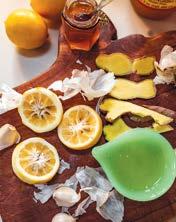
This won’t be the smoothest drink for some folks, but remember this is a hot toddy with a purpose. If needed, allow to cool to just warm or room temperature, then chug until it’s gone, drinking down all the chunky bits of garlic. I promise, you’ll thank me later.
Repeat as needed while kicking any seasonal bug.

It’s Time To Make Food Decisions With the Climate Crisis in Mind
STORY BYIf we had been told, a decade ago, that so many climatefueled disasters would hit the food system so soon, would we have believed it?
If someone had described the catastrophic flooding of the Missouri river that submerged a million acres of corn and soybeans in 2019 (followed a year later by winds in the same region that were so destructive they flattened corn silos), produce crops in Texas freezing in April, winemakers having to throw away entire vintages because they tasted of wildfire smoke, shellfish in British Columbia being literally cooked alive in the ocean and ranchers throughout the West being forced to sell off tens of thousands of cattle so they wouldn’t starve due to drought—would we have listened? Would we have done more to prepare?
I can’t help but think back to a lecture I sat in on in 2008 on the future of food and climate change by a pair of Ivy League economists. I had seen An Inconvenient Truth and was serious about local food. And I had a hunch that reducing my “food miles” wouldn’t cut it.
The economists talked about the potential boon to crop yields, due to “increased photosynthesis” and “CO2 fertilization,” but added that warming temperature and rising evaporation would balance one another out, at least in our lifetimes. Some places would get too wet, and some would be too dry, they warned. And, as if to reassure us,
they said that other parts of the world—developing nations with little infrastructure and large numbers of subsistence farmers—would face the worst of the problem. And those of us in North America? We’d be fine until at least the end of the century.
Then someone turned the lights back on, the economists thanked the audience and everyone went home. I wrote about the lecture, quoted the experts on the science and was careful to take a similarly calm tone, as if I were writing from a great distance about something that may or may not occur.
Of course, some climate scientists were already issuing dire warnings at that point, and many had made concerns about our ability to feed ourselves central to their pleas for action.
But most of us had no idea how urgently we needed to prepare for what we’re now seeing play out in the food system—and in the world at large. Indeed, the stakes couldn’t be higher. Food production has been rocked to the core and many small and medium-scale farmers are contemplating throwing in the towel.
This fact was driven home for me this summer, as I trudged through ankle-deep mud on my family’s small farm in Captain Cook, Hawaii—on what was once the “dry side of the island” but has seen record-level, nearly non-stop rainfall for the past year. My mother, a farmer, was dismayed at
the constant rain’s impact on her orchards, and by the host of new invasive species—from fire ants and wild boars to slugs that carry a brain-eating parasite—that are thriving there due to warming temperatures. The soil has been consistently saturated with water, and the coffee and fruit trees are suffering from multiple fungal diseases at once. The vegetables in the gardens are often stunted and mildewy as the sun has stubbornly refused to shine.
And I thought about those self-assured economists when I returned home to drought-stricken Northern California, where I saved water from my kitchen and shower and lugged it to the tiny garden I struggle to keep alive through the dry season. Most of the small-scale farms in the area didn’t have the luxury of reclaimed water; instead, they found themselves abandoning dozens of acres at a time, making radical changes to their business models, and discontinuing their CSAs. Meanwhile, the ongoing, often terrifying onslaught of wildfires made the mere thought of rain seem like a mirage on the other end of a very long desert.
The fact that these “new normals” have already had a dramatic impact on the food system probably shouldn’t be a surprise. Global temperatures have already risen 1.5 degrees Celsius above pre-industrial levels and the impacts are evident. The sixth assessment report published by the Intergovernmental Panel on Climate Change (IPCC) in August warned of significant drops in crop yields for corn, wheat, rice and other cereal grains if global temperatures hit the 2 degree C level. If that happens, the report said, there will be “more times of year when temperatures exceed what crops can stand” and “risks across energy, food and water sectors could overlap spatially and temporally, creating new and exacerbating current hazards, exposures, and vulnerabilities that could affect increasing numbers of people and regions.”
Among the clear list of hazards are the “food shocks” caused by extreme weather events—and they show no sign of slowing down. For these reasons, food prices are expected to grow at a steadier clip than most of us have experienced in our lifetimes. According to the United Nation’s Food and Agriculture Organization (FAO), for instance, global food prices rose by nearly 33 percent between September 2020 and September 2021.
It’s not just farmers who are scrambling to respond. Many of the world’s largest, most powerful food companies are starting to examine their supply chains in a new light, hoping to position themselves as part of the solution. Multinational food companies like General Mills, Smithfield, Unilever and Danone are all publicizing the changes they’re making in their supply chains to address emissions and rethink their farming practices. Some of these changes could have a real impact and others might just
be marketing ploys, but it’s clear that they’ve realized “sustainability” is a term they must use literally, as in, do their business models have a future?
When it comes to making sure the rest of us have a future, however, I’m betting on the work of small-scale farmers and ranchers—and more of them working at a human scale—as one of our most important solutions to the climate crisis.
If done right, farming and ranching can help bring the natural world back into balance. And it has the potential to reverse our current scenario: millions of acres of land covered in monocrops growing in soil that is overly tilled, void of most life and actively washing into the ocean nearly every time it rains.
Soil holds three times more carbon globally than the atmosphere does. And it can hold more if it’s managed in a way that brings more of it back to life. But to do that we need producers who are immensely curious and dedicated—who see the challenge at hand and want to rise to meet it.
They need to work in concert, and they need to represent a much wider swath of the population—here in North America that means intentionally making space for exponentially more young people, more Black, Indigenous, and people of color (BIPOC) producers, and more LGBTQ producers. It also means passing systemic policies that help them explore, invest in and modernize the farming practices that have long been successful at cooling the planet.
In plain terms that means we need more perennial crops, trees on farms (i.e., agroforestry and silvopasture), managed grazing, cover crops, waffle gardens and other methods of deep-soil planting, crop diversity, prescriptive burns, seed sovereignty, local food and farm infrastructure, and multitrophic aquaculture.
We need to help more farmers control weeds without tilling the soil. We need more compost on the surface of the soil and more mycelia and living ecosystems below. We also need more plants at the center of our plates. We need to spend more time listening to Indigenous communities and remembering that our needs are inextricable from the needs of the natural world, and the ecosystems that have kept it in balance for millennia.
Most of this probably won’t require new cap and trade markets, new consumer labels or new technology. But it will require more hands—and very likely a different, more collective approach to land ownership, at a moment when building housing is considered a much more valuable use of land than producing food.
None of this will mean much if we don’t also stop burning fossil fuels—and subsidizing that burning on a global scale. But





there’s more and more agreement among scientists and climate advocates that we also need to turn more of our agricultural soil into a carbon sink, and that doing so is a matter of how—not if.
The good news is that a lot of smart people are already working on the how. And that’s where your dinner—and breakfast, lunch, snacks—enter the picture.
There’s a healthy debate in both agriculture and climate circles about the value of individual action versus the need for systemic change. And food, thankfully, lies at the intersection of both. What we do—and eat—every day is who we are. When we support people who produce food with soil health and the climate in mind—whether that’s buying from them directly, using a farmers’ market dollarmatching program or dining in restaurants that cook with
their foods, it often has the curious effect of making us into the kinds of people who want to vote for—and fight for—systemic change.
I was thinking about this recently while lugging a bucket of dishwater out to my garden and feeling a little like I was wasting my time, as my neighbors were still turning on their hoses. It hurts my back, it’s absurdly time consuming. But every time I do it, I am made again and again into the person who notices water and who keeps noticing water—who notices plants, notices soil. And being that person is what makes me ache for climate policy that prioritizes survival for all.
Can we change the food system in time to help cool the planet? That’s an open question. Do we have any real choice but to try? As I see it, absolutely not.
Thank you for joining us on these pages, the third in a series of thought leadership pieces from Edible Communities. We would like to send a special thanks to our par tners for this issue, Twilight Greenaway, Naomi Starkman and the team at Civil Eats who made this story possible.
Telling powerful stories about local food and community has been the mission of Edible Communities for the past 20 years. And while I know we’ve had an impact on the way food is grown and consumed throughout North America, now more than ever there is a greater urgency for all of us to do more. A lot more.
As Twilight so elegantly points out in this article, taking individual action daily—whether recycling household water in our garden or demanding more inclusivity for those raising the food we eat—is what keeps us aware and makes us pay attention. It is what makes it impossible for us to ignore the honest reality inherent in: “What we do—and eat—every day is who we are.” And it is what will ultimately lead to systemic change.
During this holiday season and as we begin a new year, I want to express my deep and enduring gratitude to the network of wildly talented individuals who are the lifeblood of Edible Communities—the publishers, editors, contributors and staff who so diligently work to bring you these important stories throughout the year—every single one of whom has courageously and tirelessly fought to keep their local food communities alive, even in the face of a global pandemic. With independent journalism being threatened today more than at any time in our history, it’s especially important for us to support their efforts. The ability to maintain editorial independence and to dive deeply into urgent issues like the climate crisis are critical to the health of our society. That is why organizations like Civil Eats (civileats.com) are so important to us and to our mission. I encourage you to subscribe to their newsletter, donate, be informed, pay attention—help effect change.
Tracey Ryder, Co-Founder & CEO Edible Communities









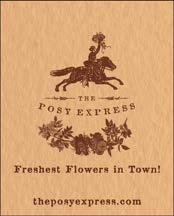







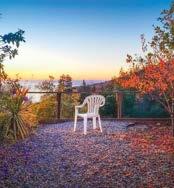
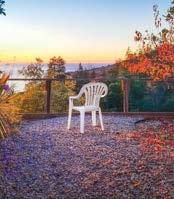



It’s Time to Connect™ in the Santa Cruz Mountains as you learn to Live, Lead, Love, Work and Wonder Well with the 1440 minutes we are gifted each day. We invite you to let your energy, discovery and creativity flourish across our private 75-acre campus and explore your potential with us beneath the energy of thousand-year-old redwoods.

Enjoy an all-inclusive weekend visit at your own pace. Nourish yourself with overnight accommodations, nutritious meals, daily Signature Classes, and access to campus amenities including private forest walking trails and outdoor infinity-edge hot tub. 1440.org/RR

Reconnect your team in person surrounded by the inspiration of nature. 1440 Multiversity welcomes singleand multi-day private events, leadership trainings, corporate retreats and more, and co-creates purposeful experiences that matter. 1440.org/Groups


Learn to Live Well and Love Well on your wedding day and beyond. 1440 Wellness Wedding programs are a mindful and holistic way to begin your new life together. Our venues set among the towering majestic trees will stimulate all the senses for you and your guests. 1440.org/Weddings
Local residents may register and take part in special campus events without booking an overnight stay. Find inspiration in a mindful movie, Tapas & Tunes experience, faculty speaking engagement and other learning opportunities, in community with like-hearted individuals. 1440.org/Events
Subscribe to our newsletter at 1440.org/Email to receive exclusive offers and campus updates. 1440 Multiversity is a Great Place to Work® Certified organization.
CREATING HOPE FOR LIVING WELL
1440.ORG/EMB | SCOTTS VALLEY, CALIFORNIA
All of these restaurants emphasize local ingredients and they also advertise in Edible Monterey Bay!

Opening information is subject to change, so please check online before you go and tell them we sent you.
Persephone 7945 Soquel Drive 831.612.6511 • persephonerestaurant.com
With a namesake like the mythic Persephone, this restaurant in Aptos proclaims its deep reverence for seasonal cooking. Themes central to harvest, winter and spring are core to Persephone’s story, and are reflected in the changing menu at this fi ne dining destination, where chef Cori Goudge-Ayer presents inventive, ingredientdriven creations. The restaurant is a family-run passion project, bringing together parents, siblings and a long history of culinary arts in a beautifully redesigned space overlooking Aptos Creek. Open Th –Sa noon–3pm and 5–9pm, Su noon–3pm.
New Leaf Community Markets 161 Aptos Village Way 831.685.8500 • newleaf.com
Th is latest branch of the beloved local market group occupies the remodeled Hihn Apple Barn, built in 1891. In addition to local groceries and organic produce, New Leaf Aptos has made-to-order sandwiches, pizza, freshly rolled sushi, soup and hand-prepped salads, as well as a coffee bar, juice and smoothie bar and organic Straus soft serve ice cream. Open daily 8am–9pm.
The Penny Ice Creamery 141 Aptos Village Way, Suite 2 831.204.2523 • thepennyicecreamery.com
Open Su–Th noon–9pm, F–Sa noon–10pm. See Th e Penny description under Santa Cruz for more.
East End Gastropub 1501 41st Avenue 831.475.8010 • eastendpub.com
East End Gastropub is a sister eatery to the popular West End Tap & Kitchen, but aside from sharing owners and chefs, East End’s beautiful, modern interior is entirely different and offers its own robust, sophisticated, beer-friendly menu. Chef Geoffrey Hargrave has created dishes that are familiar yet innovative, such as crispy Brussels sprouts with maple miso glaze and fresh fish en papillote. Shared plates, pizzas and salads come in generous portions for a familystyle meal. The restaurant also offers a rotating selection of local beer and a strong wine list. Open M–Th 4–9pm, F noon–9pm, Sa-Su 11am–3pm for brunch, and 4–9pm.
Margaritaville Capitola 231 Esplanade 831.476.2263 • margaritavillecapitola.com
For more than 30 years, Margaritaville has been welcoming guests to Capitola Village. An ownership change and complete remodel in 2015 made the restaurant better than ever, dedicated to serving Mexican cuisine made from scratch with an emphasis on fresh seafood. Th e dog-friendly patio overlooking Capitola beach is a great place to enjoy a margarita and a Baja fi sh taco, or raw oysters on the half shell. Other menu favorites are chile verde and chicken mole enchiladas. Online ordering is now available. Happy hour M–F 3–5pm. Open M–F 11:30am–9pm, Sa–Su 11am–9pm.
Mijo’s Taqueria
200 Monterey Avenue, Suite 2 831.465.0228 • mijostaqueria.com
Serving the local community and visitors alike in Capitola Village, Mijo’s Taqueria features bold and unique flavors in a new age taqueria setting. Chef Anthony Guajardo’s passion for cooking developed from being in his Mexican and Italian grandmothers’ kitchens growing up. Eager to combine his authentic family recipes with a modern culinary twist, he opened Mijo’s, conveniently located just a quick walk from the beach and available for dining in or ordering to go. Open Su–Th 11:30am–7pm, F–Sa 11am–7:30pm.
New Leaf Community Markets
1210 41st Avenue 831.479.7987 • newleaf.com
The café at the entrance off ers great alternatives to fast food, serving economical daily specials, wraps, pizza and homemade soup and espresso drinks—with free wi-fi in the outdoor dining area. Inside the market, a full deli has made-to-order sandwiches, healthy takeout salads and entrée items. Open daily 8am–9pm.
The Penny Ice Creamery
820 41st Avenue 831.204.2523 • thepennyicecreamery.com Open Su–Th noon–10pm, F–Sa noon–11pm. See The Penny description under Santa Cruz for more.
Shadowbrook
1750 Wharf Road 831.475.1511 • shadowbrook-capitola.com A Santa Cruz County landmark since 1947, the worldfamous Shadowbrook continues to be an overwhelming favorite with locals and visitors alike. Its fi ne food, extensive wine list and unparalleled setting and ambiance have earned it numerous awards, including Northern California’s “Most Romantic Restaurant” and “Best Date Night Restaurant.” Rock Room Lounge and Patio open daily noon–10pm, dining rooms open M–F 4–8:30pm, Sa 2–9:30pm, Su 2–8:30pm.
Alvarado Street Brewery & Bistro
Carmel Plaza, Suite 112 831.293.8621 • asb.beer




From the team behind award-winning Alvarado Street Brewery, the Carmel bistro off ers a full menu of ASB brews, along with hard cider, local wines and inventive craft cocktails. The menu goes beyond pub food to include oysters with mignonette or chili oil, Moroccan spiced fried chicken, crispy tempura-battered cauliflower and its popular burgers with truffle or garlic fries. Open Su–Th 11:30am–9pm, F–Sa 11:30am–10pm.
Covey Grill
8205 Valley Greens Drive 831.620.8860 • quaillodge.com/dining/coveygrill
Covey Grill features USDA steaks and sustainably sourced seafood fl avor enhanced by house-made spice rubs and sauces, in addition to seasonal American cuisine. Located inside the Quail Lodge lobby, Covey Grill off ers casually elegant indoor and outdoor dining options against the stunning backdrop of Quail’s sparkling Mallard Pond and lush garden landscapes. Open for full dinner service Th –Su 5–9pm, with bar opening at 4pm, and M–W 4–8pm with weekday menu.
Earthbound Farm’s Farm Stand


7250 Carmel Valley Road 831.625.6219 • earthboundfarm.com
At its newly renovated Carmel Valley Farm Stand, Earthbound Farm’s 100% certified organic kitchen delights with housemade soups, sandwiches, salads, baked goods and fresh juices and smoothies. Food is available to be enjoyed on our beautiful grounds or for takeaway. Stroll through the gardens and learn about Earthbound’s commitment to organic integrity. Open daily 8am–6pm.
Grasing’s 6th Avenue and Mission 831.624.6562 • grasings.com
Chef-proprietor Kurt Grasing’s namesake restaurant has expanded since opening in 1998 to include two large dining rooms, multiple outdoor dining areas and the ever-popular bar/lounge. A Carmel classic located in the heart of the village, Grasing’s serves California cuisine, with an award-winning wine list and twists on traditional cocktails. Open daily M–F noon–3pm and 5–9pm, Sa–Su 10:30am–3pm and 5–9pm.
Rio Grill 101 Crossroads Boulevard 831.625.5436 • riogrill.com
Deeply fl avorful Southwestern cuisine is the specialty that executive chef Luis Osorio brings to the table for lunch and dinner. Go exotic with a corn truffl e and wild mushroom tamale, go local with the fi re-roasted Castroville artichoke or go wild west with an order of almond wood smoked BBQ pork back ribs. Open Su–Th 11:30am–8pm, F–Sa 11:30am–9pm.
Sea Harvest Fish Market & Restaurant 100 Crossroads Boulevard, Suite A 831.626.3626 • seaharvestfishmarketandrestaurant.com
The Deyerle family that owns this local gem has its own fi shing boats for the freshest catch on the Monterey Peninsula. Sea Harvest doubles as a fi sh market and casual restaurant with indoor and outdoor seating. The oysters and clam chowder are customer favorites, but don’t miss the fried combo platter, grilled fi llets and fi sh tacos. Open daily 8am–8pm.
San Carlos Square, Between 5th and 6th avenues 831.250.7183 • thestationaery.com
A neighborhood restaurant off ering daily brunch and dinner, Stationaery is owned by your hospitable hosts Anthony and Alissa Carnazzo. The kitchen team, led by chef Amalia Scatena, specializes in comforting fl avors and local ingredients, with elegant presentations. Open Th –M 8am–2pm, 4–8pm. Closed Tu–W.
Jerome’s Carmel Valley Market



2 Chambers Lane 831.659.2472 • jeromescarmelvalleymarket.com

A chef-owned, friendly neighborhood market, Jerome’s offers local and organic produce, natural meats and seafood, and a great selection of domestic and imported wine, beer and microbrews. French-trained chef and owner Jerome Viel prepares delicious hot foods, sandwiches and salads for eating at outdoor seating or take-away. The offerings start with breakfast burritos, croissants and other French pastries in the morning, followed by favorites such as coq au vin, spaghetti carbonara and chicken enchiladas for lunch and dinner. Open M–Sa 7am–7pm, Su 7am–6pm.
Lucia Restaurant & Bar
Bernardus Lodge & Spa • 415 W. Carmel Valley Road 831.658.3400 • bernarduslodge.com

Indulge in artisanal California country cuisine, awardwinning wines and an expansive heated outdoor terrace with the fi nest restaurant view in Carmel Valley. Named for the Santa Lucia mountain range and wine appellation that beckons to the south, Lucia offers both a signature tasting menu and dishes à la carte. Wine list is equally notable. A private chef’s table and wine cellar table are also available for special occasions. Open daily 7am–10pm.
Wild Roots Market
6240 Highway 9 • 831.335.7322 (Felton) 13159 Highway 9 • 831.338.7211 (Boulder Creek) wildrootsmarket.com

Wild Roots’ 100% organic produce, natural groceries, organic meats and FishWise-certified seafood all go into the prepared foods offered by the store’s full-service deli, salad and soup bar and juice bar. Enjoy on the patio out in front or take home. Open daily 9am–9pm.
Alta Bakery + Café 502 Munras Avenue 831.920.1018 • altamonterey.com

Set inside the historic Cooper Molera Adobe with a sunny outdoor patio, Alta Bakery is a bustling coffee house with exquisite breads and pastries from culinary director Ben Spungin and his team. Light lunch options change with the seasons and are beautifully presented, including salads, soups and the much-Instagrammed “obligatory avocado toast.” Open daily 7am–4pm.
Elroy’s Fine Foods 15 Soledad Drive 831.373.3737 • elroysfi nefoods.com
The dream market of owners Jay and Chloe Dolata, Elroy’s has an extensive range of gourmet groceries, local seafood, natural meats and fresh organic produce. It also boasts a kitchen with a wood-fi red grill and prepared foods to go or to eat in. The Bar @ Elroy’s serves coffee, smoothies and a savvy selection of natural wines. Open M–Sa 8am–8pm, Su 9am–7pm.
Estéban Restaurant 700 Munras Avenue 831.375.0176 • estebanrestaurant.com
At the heart of the downtown Monterey dining scene, Estéban Restaurant serves Spanish influenced cuisine made from fresh, local, and seasonal ingredients. Th e menu features a selection of long-time Estéban favorites, as well as fresh, new dishes created by executive chef Mario Garcia, who spins out wonderful dishes like Crispy Pulpo, served with remoulade, Yukon potato, chorizo, rosemary chili oil and grilled radicchio. Open for dinner nightly 4–8pm. Tapas hour from 4–6pm nightly.
Montrio
414 Calle Principal 831.648.8880 • montrio.com
Closed for remodeling as of press time, Montrio is expected to reopen this winter with a refreshed dining room and a menu that includes elevated customer favorites, as well as new dishes utilizing the bounty of the Monterey Bay and local farms. Check online for opening information.
Sea Harvest Restaurant & Fish Market
598 Foam Street 831.626.0547 • seaharvestmonterey.com
Th is fresh and casual seafood spot near Cannery Row is perfect after a day exploring the Monterey Bay Aquarium. There are grilled entrées and lots of fried options with chips, including calamari, clams, prawns, scallops and oysters. Try Sea Harvest’s popular clam chowder or a basket of crispy artichoke hearts. Open daily 9am–7pm.
Stokes Adobe 500 Hartnell Street 831.264.8775 • stokesadobe.com
Located in one of Old Monterey’s historic adobe homes, now beautifully restored, Stokes Adobe offers fresh pastas made in house, truffle chicken and shareable appetizer plates. The bar and cozy outdoor fire pits feature seasonally inspired classic cocktails, and a selection of quality wines by the glass and local beer. Friendly, welcoming staff make sure your visit feels like coming home. Open Th –Sa 5–9pm. Check online for expanded days, hours, lunch and brunch service.
Tarpy’s Roadhouse

2999 Monterey-Salinas Highway 831.647.1444 • tarpys.com


An award-winning steakhouse serving generous portions of California comfort food, Tarpy’s Roadhouse occupies a sprawling 3½-acre property and stone building that used to be part of the Ryan Ranch homestead. In addition to expertly prepared steak, enjoy wood-fired salmon, chile-crusted chicken, braised lamb shank, classic meatloaf and smoked baby back ribs. Open Su–Th 11:30am–8pm, F–Sa 11:30am–9pm.
Wild Plum Café & Bakery



731 Munras Avenue 831.646.3109 • thewildplumcafe.com
Located in Old Monterey in a vibrant and diverse neighborhood, Wild Plum draws people from all walks of life with sustainable bistro fare that uses organic, locally sourced produce, hormone-free Diestel turkeys roasted on site, grass-fed beef and house-baked bread and pastries. Breakfasts include scrambles, omelets, and breakfast tacos and burritos, and for lunch, choose among soups, salads, sandwiches and paninis, burgers and house specialties. Food to go and catering available. Open W–M 7:30am–3:30pm, Tu closed.
Sea Harvest 2420 Highway 1 831.728.7081 • @seaharvestmosslanding
Outdoor tables on a wooden deck overlooking Elkhorn Slough are the perfect place to enjoy fresh seafood hauled in by a fi sherman who is part of the Deyerle family that runs the restaurant. Choose from grilled catch of the day, shrimp Louie, fi sh and chips or some of the best Bajastyle battered fi sh tacos around. Open daily 11am–7pm.
Happy Girl Kitchen Co.

173 Central Avenue 831.373.4475 • happygirlkitchen.com
The menu changes daily at Happy Girl’s airy and bright Pacific Grove café, but the food is always delicious, organic and reasonably priced. The sandwich of the day, bowl of the day and soup of the day are always a good bet. To drink, you’ll fi nd kombucha on tap and freshly roasted Captain + Stoker coff ee brewed to perfection.
Homemade baked goods include a daily scone, cookies and turnovers. Open daily 7am–5pm.
Julia’s Vegetarian
1180 Forest Avenue, Suite F 831.656.9533 • juliasveg.com

Voted the best vegetarian restaurant on the Monterey Peninsula for more that 10 years running. Julia’s is known for its wild and exotic mushrooms and housebrewed kombuchas on tap. The menu features a creative twist on vegan, vegetarian and gluten-free food. Try some of the most popular dishes like the fried “egg & bacon” sandwich, exotic mushroom sampler and buffalo cauliflower wings. Open Su–Th 10am–8pm, F–Sa 10am–9pm.
Mezzaluna 1188 Forest Avenue 831.372.5325 • mezzalunapasteria.com
Owners Chef Soerke Peters and Amy Stouffer keep their restaurant simple and amazing—and chef Peters is a leader in sustainability on the Monterey Peninsula. Pasta, mozzarella and gelato are made fresh daily. Starters include clam chowder with torched bone marrow, duck liver pâté and grilled octopus, and there are fi ve dishes starring locally crafted mozzarella. Pasta choices are imaginative and include options such as pappardelle with wine braised rabbit, Dungeness crab ravioli and potato gnocchi with gorgonzola and black truffle oil. Open W–Su 5–9pm. Closed M–Tu.
Wild Fish 545 Lighthouse Avenue 831.373.8523 • wild-fi sh.com
Owners Liz and Kelvin Jacobs welcome you to feast on the bounty of nearby waters and farms at their 100% local and organic seafood house, enjoying exquisite dishes like crispy sablefi sh, halibut and petrale sole, accompanied by local vegetables. Fresh oysters, innovative salads, house-baked bread and sides like fi ngerling potatoes with poppyseed crème fraîche or baby carrots with wild nettle pesto, make this a dining destination. Did we mention English sticky toffee pudding for dessert? Open Su–Th 11:30am–3pm and 5–8:30pm, F–Sa 11:30am–3pm and 5–9:15pm.
Barceloneta
1541 Pacific Avenue, Suite B 831.900.5222 • eatbarceloneta.com

With its cheerful beach stripes, wicker light fi xtures and whimsical details, dinner at Barceloneta can feel like a holiday. Owned by chef Brett Emerson and his wife Elan, who ensures service is superb, Barceloneta off ers Spanish tapas made with seasonal, farmers’ market produce and several types of authentic paella, along with Spanish wines, beers and cocktails. Open Tu–Sa 5–8:30pm. Closed Su–M.
Charlie Hong Kong
1141 Soquel Avenue 831.426.5664 • charliehongkong.com
Charlie Hong Kong has been providing the Santa Cruz community with healthy, sustainable, aff ordable and high-quality food since 1998. The colorful, casual eatery’s delicious fusion of Southeast Asian influences and the Central Coast’s local organic produce has made it an inclusive, family-friendly, neighborhood favorite. Its slogan is “love your body, eat organic,” and its cuisine is proof that fast food can be good for you. All signature dishes are vegan with the option to add meat or fi sh.

Gluten-free options are available. Dog friendly. Open daily 11am–10pm.


Chocolate 1522 Pacific Avenue 831.427.9900 • chocolatesantacruz.com
As its name suggests, there are all kinds of decadent chocolate desserts at Chocolate the restaurant, but this farm-to-fork local favorite is much more than a dessert spot. Everything is prepared simply and with local and organic ingredients whenever possible. Open Tuesday through Sunday for dinner, options include three kinds of chicken mole, roast pork with chocolate barbecue sauce, and their signature Pasta Rosettes! Cocktails feature Santa Cruz-based distilleries, including Venus Spirits. Check out their extensive hot chocolate menu. A party room for your special celebration is available, with seating and menu options to suit the occasion. Open Tu–Th and Su 4–8pm, F–Sa 4–9pm. Closed M.
Crow’s Nest 2218 E. Cliff Drive 831.476.4560 • crowsnest-santacruz.com
A perfect spot to enjoy breakfast and lunch or catch a dinnertime sunset over the harbor, the nautical-themed Crow’s Nest is a Santa Cruz institution that never goes out of style. There’s always something happening, from live music to comedy nights and happy hours. Famous for its salads, house-smoked salmon and seafood entrées, the Crow’s Nest is a member of Seafood Watch and is a certified green business. Open M–F 9am–8:30pm, Sa–Su 8am–8:30pm.

Laílí 101B Cooper Street 831.423.4545 • lailirestaurant.com
Exotic fl avors of the Silk Road are served in a stylish dining room decorated in eggplant and pistachio colors and on a hidden candlelit patio. Locals rave about Laílí’s homemade naan served warm from the oven with a selection of Mediterranean dips. There is a wide variety of deliciously spiced vegetable dishes, and all meats are hormone free and free range. Check website for opening information.
La Posta 538 Seabright Avenue 831.457.2782 • lapostarestaurant.com
A cozy neighborhood bistro not far from the Santa Cruz yacht harbor, La Posta chef Rodrigo Serna prepares traditional rustic Italian cuisine using local ingredients. The emphasis is on simple, seasonal selections, with the balance of the menu reflecting whatever produce is freshest right now. A sister restaurant of Soif Restaurant and Wine Bar, La Posta also offers a great selection of wines. Open W–Su 5–8pm, closed M–Tu.
New Leaf Community Markets 1134 Pacific Avenue 831.425.1793 • newleaf.com
New Leaf’s headquarters in a former bank building on Pacific Avenue is a worthwhile stop for all foodies. Crowded with gourmet natural foods, it also has a deli with sandwiches, salads and hot entrées. A dining area out front is great for people watching and listening to street musicians. Open daily 8am–9pm.
New Leaf Community Markets 1101 Fair Avenue 831.426.1306 • newleaf.com
The Westside New Leaf has a large deli counter and coffee bar, with a big selection of sandwiches, salads, bakery items, soups and other hot foods. You can eat at an instore counter or at tables outside. Open daily 7am–9pm.
Pearl of the Ocean 736 Water Street 831.457.2350 • facebook.com/pearloftheoceanca Award-winning chef/owner Ayoma Wilen goes beyond the expected traditional spice-infused dishes of Sri Lanka, creating locally inspired daily specials using fresh, organic produce from farmers’ markets and sustainably harvested seafood. Customer favorites include butternut squash curry, crab curry and wild salmon curry. To round out the flavor experience, there is a dizzying array of sides, like coconut leek sambal and kale mallam. The warm colors, altars and blessings that decorate the space help guests get a sense of Sri Lanka’s world-class hospitality, culture and beauty. Open daily 5–9pm.
The Penny Ice Creamery 913 Cedar Street 831.204.2523 • thepennyicecreamery.com
Lines out the front door of its converted Spanish bungalow are evidence of Penny’s popularity. All ice cream, including bases, is made from scratch on the premises using local organic ingredients when possible. Dozens of exotic fl avors rotate seasonally, but two favorites are chocolate caramel sea salt and strawberry pink peppercorn. Open daily noon–11pm.
The Picnic Basket 125 Beach Street 831.427.9946 • thepicnicbasketsc.com
Across the street from the main beach, owners of The Penny Ice Creamery have opened an alternative to boardwalk fast food. Sandwiches, organic salads, coffee and beer, all from local food artisans, and of course Penny’s popular ice cream, are all on offer to eat in or outside with your feet in the sand. Open daily 7am–4pm.
Snap Taco 1108 Pacific Avenue 831.824.6100 • eatsnaptaco.com
Th is festive taco spot draws its inspiration from food traditions around the world, with imaginative tacos created using the best fresh, local and sustainable ingredients. Great for a quick bite or gathering with friends and family. Choose from snacks, tacos, bowls and sandwiches on the menu, as well as draft beers, the Snap Rita and specialty cocktails. Open Su–Tu and Th 11:30am–9pm, F–Sa 11:30am–10pm, closed W.
Soif Restaurant and Wine Bar 105 Walnut Avenue 831.423.2020 • soifwine.com

Inspired by the offerings from local farmers and purveyors, executive chef Tom McNary’s cuisine shows California fl air with super, seasonal dishes, all paired with local and hard-to-fi nd wines, or a rotating selection of unique house cocktails. The bottle shop next door provides a world-class selection of wines and good advice on what to order. Raw oysters available on Wednesdays. Open W–Sa 1–8pm, Su noon–4pm, closed M–Tu.

Staff of Life 1266 Soquel Avenue 831.423.8632 • staffofl ifemarket.com



A Santa Cruz landmark, Staff of Life started in 1969 as a small natural foods bakery and has grown over the years into a full service natural foods supermarket known for its local organic produce, seafood and natural meats as well as an extensive bulk department. Deli items and foods from the hot bar can be enjoyed at the Café del Sol. Open daily 8am–9pm.
Venus Spirits Cocktails & Kitchen
200 High Road 831.600.7376
• venusspirits.com


Craft distiller Sean Venus has his new facility fully operational. It includes a lively restaurant bar, the distillery itself and a tasting room. If you want to sample his award-winning gin and other spirits, try the tasting room. For cocktails and hearty plates from chef James Manss, head for the kitchen part of the building and enjoy dishes like crispy Brussels sprouts, mole baby back ribs and elote chile relleno. Open W–F 4–9pm, Sa noon–9pm, Su noon–8pm.
West End Tap & Kitchen 334D Ingalls Street 831.471.8115 • westendtap.com
Perfect for any parent looking for a happy hour to satisfy the whole family, adults and kids alike can’t get enough of the duck fat popcorn, fried calamari and flatbread pizzas. A diverse, season-driven menu with off erings like New York strip steak panzanella, seared oyster mushroom “scallops,” a Southern-style seafood boil and a long list of craft beers, ciders and wine options make West End a Westside staple. The outdoor patio is perfect for people watching amidst the bustling Swift Street Courtyard. Open daily noon–9pm.
Beer Mule Bottle Shop + Pour House
45 Aviation Way 831.254.9789 • kickassbeer.com
The Beer Mule has 40 brews on tap and hundreds more in the fridge, with an emphasis on local and NorCal beer. Food—courtesy of Butchers & Th e Mule—includes dishes like four-cheese mac and cheese, barbacoa short rib tacos, grilled tri-tip cheesesteak, hot or not fried chicken sando and Butchers’ jambalaya. Open daily 11am–10pm.
Gizdich Ranch 55 Peckham Road 831.722.1056 • gizdich-ranch.com
Visitors from all over love this fourth-generation, familyrun farm business that popularized the “pik-yor-self” experience just east of Watsonville’s Interlaken neighborhood. Tour the farm, pick fresh apples or berries or watch the action inside the juice-pressing barn. No one leaves hungry if they spend time at the bakery-deli that pleases with its fresh pies, shortcakes and pastries, along with hearty sandwiches and box lunches. Th is family friendly experience is also a treat for kids, who will enjoy the wide-open spaces and the homemade popsicles. Open daily 9am–5pm.
Staff of Life 906 E. Lake Avenue 831.726.0240 • staffofl ifemarket.com
Opened last spring, Staff of Life’s second store in Watsonville is its fi rst and only branch. The store is sustainable down to its bones and includes all the natural groceries, organic produce and baked goods you’d fi nd at the Santa Cruz store, along with a juice and smoothie bar, freshly made sushi, a gelato bar, a full deli and a hot bar. Open daily 8am–8pm.

Each season I am delighted with the oddly shaped offerings from my thorny citrus sacrodactylis, otherwise known as Buddha’s hand. It is the only citron with segmented fingers resembling striking variations of the Buddhist mudras or hand gestures. I often notice spiders and their catch lurking between the fingers and imagine what a delightful and intoxicating home a Buddha’s hand would be.
Buddha’s hand is one of the oldest citrus fruits and the first to be propagated mainly for offerings at temples. Originally from India, they were brought by traveling monks to China, where they are considered a symbol of longevity, happiness and good fortune. Traditionally this unique citron was given as a New Year’s gift. Their intoxicating, sweet scent would permeate the homes and clothing of the recipients.
The large leaves of the Buddha’s hand are attached to branches with long, intimidating thorns. Their purple-tinged white flowers have a beautifully sweet scent that attracts bees and humans alike. As they grow, the long, green fingers resemble sea creatures until they develop a bright sunshine hue. Unlike other citrus, this fruit has no juice, seeds or pulp. It consists of yellow rind and spongy white, sweet pith, all of which are edible.
If you can locate the elusive Buddha’s hand, be sure to get at least three with which to try various preparations. This aromatic citron can be used as a tonic, made into candy, zested to brighten cooked foods, added to baked goods and desserts and begs to be made into cocktail fixings.
Here are 10 simple ways to enjoy this fabulous fruit:
1. Infuse pieces of rind, pith and leaves in hot water for an anti-inflammatory tea.
2. Zest the rind and dry it in the oven. Using a mortar and pestle, crush it with coarse salt. Use in cooking to brighten dishes or for the rim of a margarita.
3. Mix dried rind with sugar and use to rim glasses for a cocktail.
4. Candy the entire Buddha’s hand in chunks. Add fresh ginger to the candy syrup for an extra kick.
5. Make Buddhacello: Infuse a neutral spirit of high alcohol content with long pieces of the rind. For full flavor, let sit for 2 to 4 weeks before adding simple syrup to make the liqueur.
6. Pickle large chunks of both the rind and the pith using a salt brine.
7. Include in baked goods for a chewy, zesty addition.
8. Make vinaigrette: ¼ cup olive oil, a few splashes of fresh lemon juice, zest from Buddha’s hand, fresh garlic, salt. Let sit overnight.
9. Include zest in pumpkin bread for a chewy texture and bright flavor that complements the warm spices.

10. Make a natural household cleaner by putting long pieces of zest in white vinegar.
Buddha’s hand is one tree that deserves a space in the garden and on your altar. It will be greatly appreciated for its culinary delights, beauty and novelty.



